Cultural and Historical Symbols
Native American Symbols and Their Meanings
Explore the rich tapestry of Native American symbols and meanings, uncovering the cultural significance behind traditional motifs and spiritual icons.
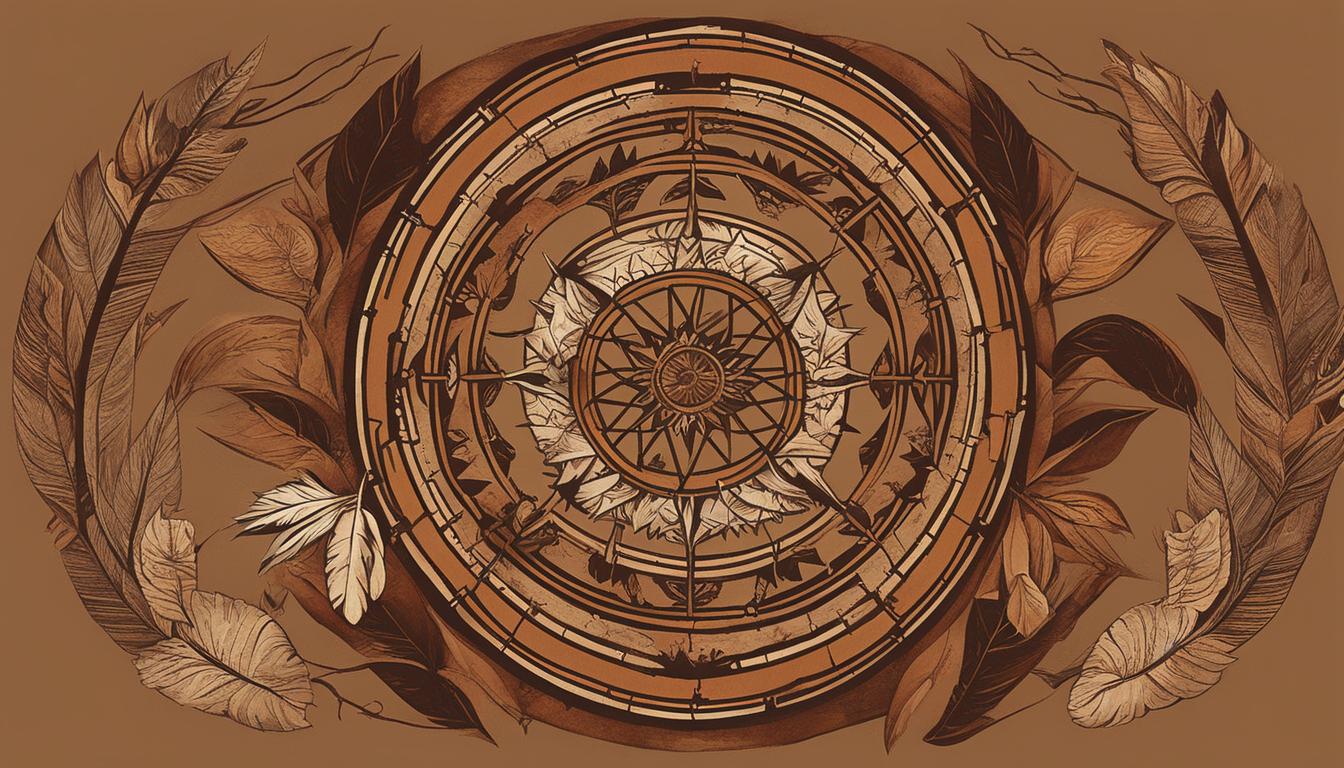
Ever wondered about the meaning behind Native American symbols? They’re not just fancy designs but carry **deep cultural and spiritual significance**. **Passed down through generations**, these symbols are still super important in Native American culture today. Take the arrow, for instance. It stands for protection and defense. And the bear? It symbolizes spiritual power and courage. **Every symbol has a story** and a powerful meaning, waiting to be discovered.
Key Takeaways:
- Native American symbols carry deep cultural and spiritual significance.
- These symbols have been passed down through generations.
- Each symbol represents a unique story and holds profound meaning.
- Some common symbols include the arrow, bear, buffalo, butterfly, and eagle.
- These symbols bridge the gap between the visible and the spiritual world.
The Arrow and Arrowhead
The arrow is a symbol of protection and defense in Native American culture. It represents the literal bow and arrow used for hunting in tribes across the continent. This powerful symbol embodies the courage and skill required for survival in the natural world.
With its slender and pointed shape, the arrowhead carries its own significance. It not only serves as a physical tool for hunting and warfare, but also as a symbol of alertness and direction. The arrowhead reminds us to stay vigilant and focused in order to navigate life’s challenges.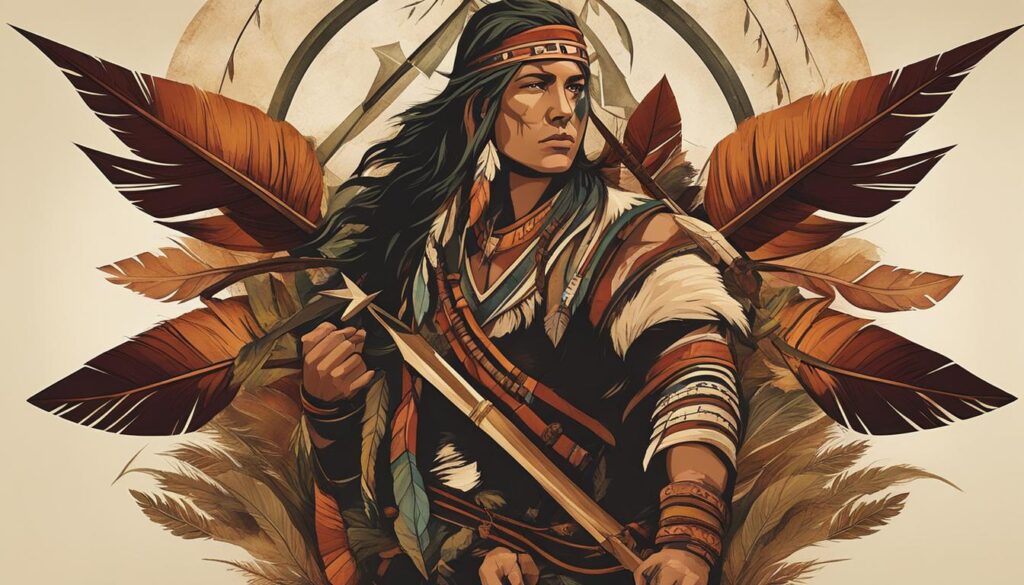
The Bear and Bear Claw
The bear is a sacred animal in Native American culture, symbolizing spiritual and physical power as well as courage. It is revered for its strength and resilience, embodying the qualities that Native Americans strive to possess.
The bear claw, on the other hand, holds deep symbolism and significance. It represents protection and is seen as a talisman of strength and bravery. Native Americans wear bear claws as a symbol of their connection to the bear spirit and their aspiration for leadership.
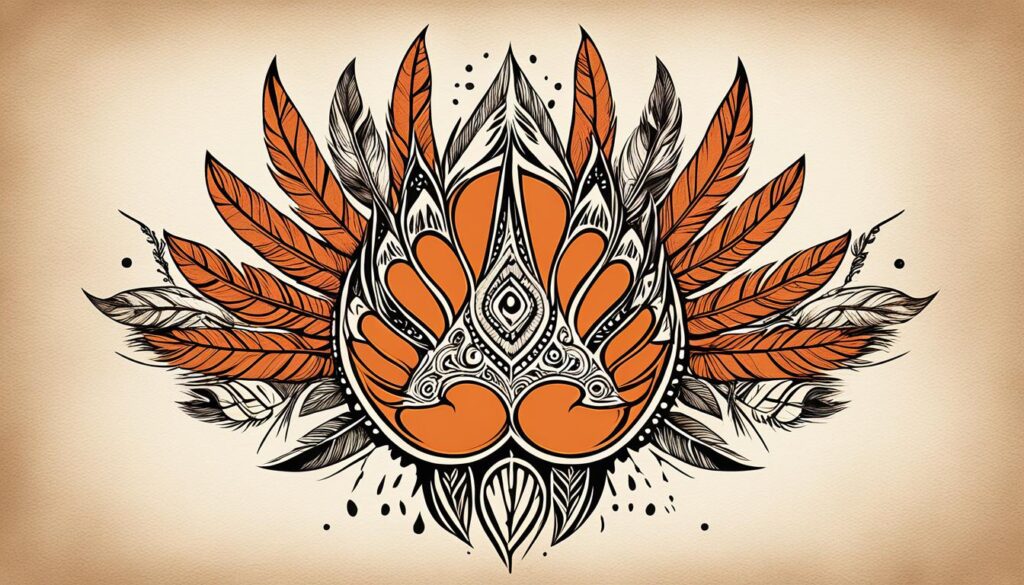
The Spiritual Power of the Bear
In Native American culture, the bear is associated with spiritual power. It is believed to possess a strong connection to the spiritual realm and is often seen as a guardian and guide. The bear’s immense strength and fearlessness serve as a reminder of the importance of courage and perseverance.
The bear is like a mighty force of nature, embodying both the physical and spiritual power that we seek. Its energy inspires us to tap into our own inner strength and face life’s challenges with courage and determination.
The Bear Claw as a Symbol
The bear claw is a symbol of protection and defense. It represents the ability to overcome obstacles and protect oneself and loved ones from harm. Native Americans believe that wearing a bear claw brings luck, strength, and courage.
Traditionally, the bear claw is worn as a pendant or incorporated into jewelry. It serves as a constant reminder to stay connected to one’s inner power and embrace the qualities of the bear.
Leadership and the Bear Claw
In Native American culture, wearing a bear claw is often associated with leadership. It is believed that those who possess the bear’s spirit and wear the claw have the qualities needed to guide and protect their community.
“The bear claw represents not only strength and protection but also the responsibility and courage that come with leadership. It is a symbol of the leader’s commitment to the well-being of their people and the ability to make wise decisions.”
The Importance of the Bear and Bear Claw
The bear and bear claw hold significant spiritual and cultural meaning in Native American traditions. They teach us the value of inner strength, courage, and the ability to protect oneself and others. These symbols remind us to tap into our own power and embrace the qualities of the bear as we navigate life’s challenges.
| Bear Symbolism | Bear Claw Symbolism |
|---|---|
| Spiritual and physical power | Protection and defense |
| Courage and resilience | Connection to the bear spirit |
| Guidance and strength | Leadership and responsibility |
Brotherhood and Loyalty
In Native American culture, the concept of brotherhood holds a deep significance. It represents the strong bond and loyalty between individuals or tribes, fostering unity and solidarity. Brotherhood goes beyond blood relations to encompass a sense of kinship and mutual support among members of a community.
This belief in brotherhood emphasizes the importance of standing together and supporting one another, especially in times of adversity and challenges. Native American tribes understand the power of collective strength and the benefits of cooperation and collaboration.
Brotherhood also symbolizes duality and balance in relationships. Just as brothers have a unique connection, Native American tribes seek to establish harmony and equilibrium within their communities. This balance promotes understanding, respect, and fairness among individuals, ensuring the smooth functioning of social structures.
Moreover, brotherhood extends beyond human relationships to include a deep sense of connection with nature and the spiritual world. Native American tribes recognize the interconnectedness of all living beings and their responsibility to maintain harmony with the natural world.
“In brotherhood, we find strength and balance. Together, we can overcome any challenge and achieve greatness.”
By honoring the bonds of brotherhood and embracing loyalty, Native American cultures emphasize the value of unity and shared goals. The sense of belonging and unity fostered by brotherhood creates a strong foundation for communities to thrive and prosper.
The Dual Nature of Brotherhood
Brotherhood carries a dual nature in Native American culture, representing both deep bonds within a tribe and the recognition of the duality of existence. This duality encompasses the concept of balance and the interconnectedness between opposing forces.
Native American tribes understand that life is a delicate balance between light and dark, joy and sorrow, creation and destruction. Brotherhood serves as a reminder to maintain equilibrium and embrace both sides of this duality.
Just as brothers support and uplift each other, Native American traditions emphasize the importance of finding balance within oneself and within relationships. This balance extends to the broader context of the natural world, where opposing forces coexist in a delicate dance of creation and renewal.
The Symbolism of Brotherhood
Brotherhood is often depicted in Native American art and symbolism through visual representations of siblings or intertwined figures. These images serve as a reminder of the interconnectedness of all beings and the importance of fostering strong relationships.
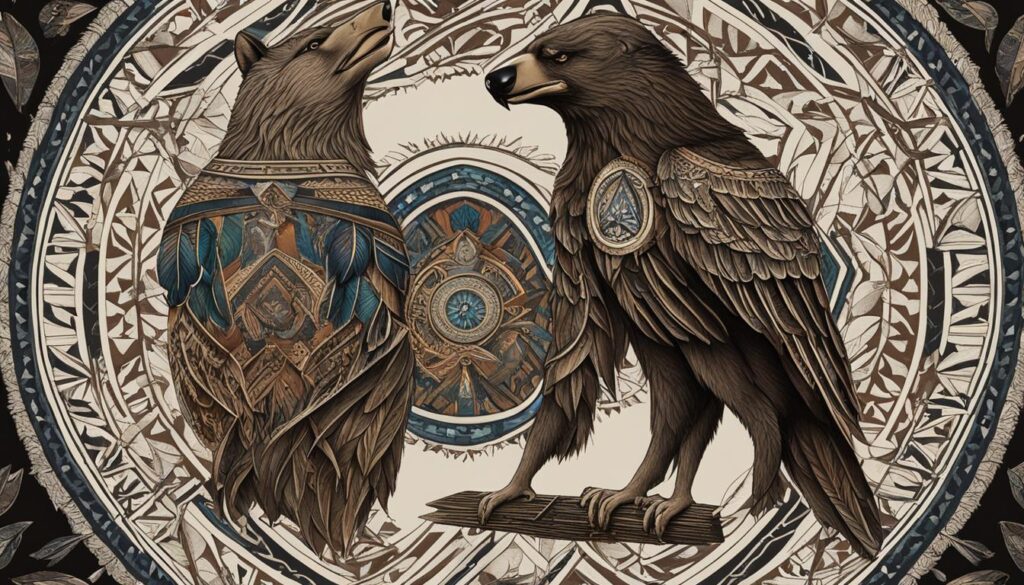
This image showcases two figures locked in an embrace, symbolizing the bond of brotherhood. The intertwined bodies represent unity, while the circle formed by their arms signifies the eternal nature of this connection.
Through the symbolism of brotherhood, Native American cultures impart the values of loyalty, unity, balance, and interconnectedness. By embracing brotherhood, individuals and tribes can cultivate a sense of community and foster harmonious relationships, ultimately contributing to a more balanced and interconnected world.
The Buffalo and Humbleness
The buffalo, also known as the American Bison, holds great cultural significance in Native American culture. It serves as a symbol of sustenance, providing both food and materials for various aspects of everyday life. The buffalo embodies the idea of sustaining life and the importance of taking only what one needs.
The Native American tribes relied heavily on the buffalo for survival, utilizing every part of the animal to honor its sacrifice. The meat provided nourishment, the hide was used for clothing and shelter, and the bones and horns were transformed into tools and instruments. This sustainable approach to utilizing the buffalo’s resources exemplifies the value of humbleness and gratitude towards nature.
“The buffalo is a majestic creature that teaches us to live in harmony with the land and appreciate the interconnectedness of all living beings. Its humbling presence reminds us of the delicate balance required to sustain life.” – Chief Running Water
The buffalo is not only a physical presence in Native American culture but also holds a spiritual significance. It symbolizes strength, abundance, and resilience. Native American tribes believe that the buffalo possesses sacred wisdom and that its spirit can guide humans in navigating the challenges of life.
By embodying the spirit of the buffalo, individuals are encouraged to embrace humbleness, recognizing their place within the greater ecosystem. They learn to respect and honor the resources provided by the earth, understanding that taking more than necessary disrupts the delicate equilibrium of nature.
Buffalo Population in North America
Over the centuries, the buffalo population in North America has faced significant challenges due to human activities and environmental changes. In the 19th century, mass hunting and habitat destruction led to a drastic decline in the buffalo population, bringing it dangerously close to extinction.
However, conservation efforts and a growing awareness of the importance of preserving this iconic species have helped revive the buffalo population. Today, the American Bison is considered a conservation success story, with efforts to protect and restore their habitats proving fruitful.
Here is a table showing the estimated population of American Bison in North America:
| Year | Estimated Population |
|---|---|
| 1800 | 30-60 million |
| 1890 | 700 |
| 2021 | approximately 500,000 |
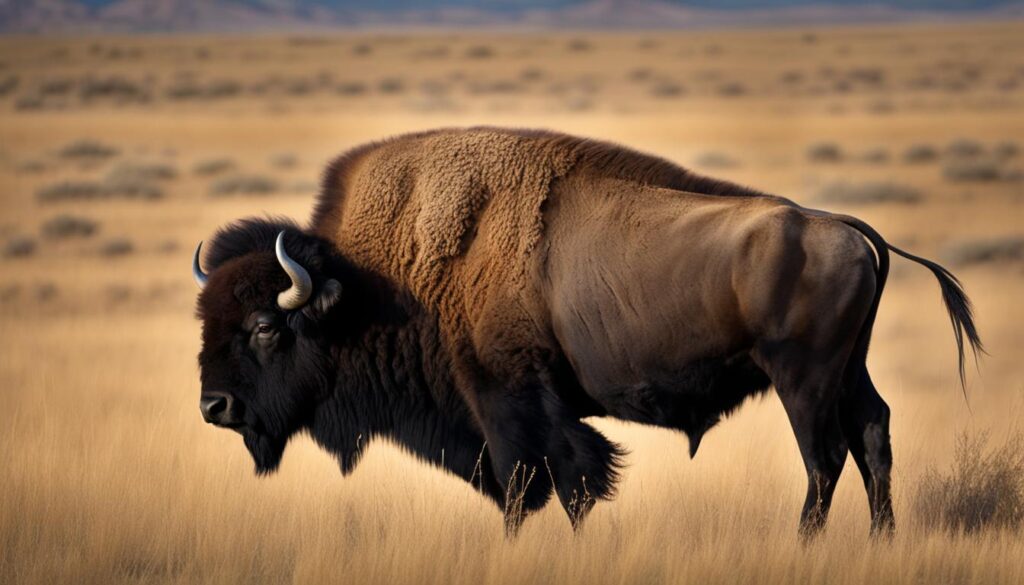
The Butterfly and Transformation
The butterfly is a common symbol in Native American jewelry, representing transformation and rebirth. It is believed to carry powerful spiritual messages and is seen as a messenger from the spirit world. This beautiful creature undergoes a remarkable metamorphosis, transitioning from a humble caterpillar to a magnificent butterfly, symbolizing the potential for personal growth and change.

The butterfly’s journey from a crawling insect to a vibrant flyer is a symbol of transformation. Its transformative process inspires Native Americans to embrace positive change, leaving behind old patterns and embracing new beginnings. Just like the butterfly emerges from its cocoon, individuals can also shed their limitations and embrace their true potential.
Furthermore, the butterfly is considered a messenger from the spirit world. Native American tribes believe that these delicate creatures bring messages of peace, harmony, and spiritual growth. As a messenger, the butterfly acts as a bridge between the physical and spiritual realms, reminding us of the interconnectedness of all living beings.
| Symbol | Representation |
|---|---|
| Transformation | The metamorphosis from caterpillar to butterfly signifies personal growth and change. |
| Rebirth | The butterfly’s emergence from the chrysalis represents new beginnings and fresh start. |
| Messenger from the spirit world | The butterfly carries messages of peace, communication, and spiritual growth. |
“Like a butterfly, we too can transform and leave behind the burdens of the past, embracing a beautiful journey of self-discovery and growth.” – Native American Proverb
Appreciation for the butterfly’s transformative journey extends beyond symbolism. Native American artisans depict butterflies in their art and jewelry, honoring the beauty and significance of this enchanting creature. The butterfly’s delicate wings and vibrant colors serve as a reminder to embrace change and find beauty in every stage of life.
The Cactus and Endurance
In Native American culture, the cactus is recognized as a powerful symbol of protection and endurance. Just like the cactus thrives in the tough desert conditions, it serves as a reminder to withstand difficult situations and persevere through challenging times.
The cactus’s ability to survive and flourish in arid environments speaks to its remarkable endurance. Despite the harsh conditions it faces, the cactus stands tall and continues to grow, representing the resilience and strength that individuals can possess.
Similar to how the cactus’s spines provide physical protection, this symbol also represents the need for emotional and spiritual protection. It encourages individuals to guard themselves against negativity, harmful influences, and challenging circumstances.
Moreover, the cactus teaches the importance of adaptation and the ability to thrive in unfavorable conditions. It exemplifies the capacity to make the best of any situation and find opportunities for growth and flourishing, even in the face of adversity.
Embracing the qualities of the cactus can bring about a sense of inner strength and the determination to overcome obstacles. It encourages individuals to stay true to their values and beliefs, unwavering in the face of challenges, and steadfast in their pursuit of goals.
Endurance and Protection in Native American Culture
The Native American people have long recognized the cactus as a powerful symbol of endurance and protection. It is often incorporated into traditional tribal ceremonies, artwork, and jewelry, signifying its cultural significance.
“The cactus teaches us to withstand the hardships of life and reminds us that protection is not just physical, but also encompasses emotional and spiritual well-being.” – Chief Standing Bear
Native American tribes infuse these symbols into their daily lives to draw strength and guidance from the natural world around them. Through the enduring presence of the cactus, they find solace in their ability to withstand life’s challenges and protect what is most important to them.
As with all symbols, the interpretation of the cactus may vary among different Native American tribes and individuals. However, its essence of endurance and protection remains a central theme across Native American cultures.
Image of a Cactus

| Symbol | Meaning |
|---|---|
| Cactus | Protection and endurance |
| Arrow | Direction and defense |
| Bear | Spiritual power and courage |
The Circle and Its Variations
In Native American culture, the circle symbolizes a multitude of meanings and holds significant importance. It is a powerful representation of unity, interconnectedness, and the cyclical nature of life. The circle can be found in various forms throughout Native American art and symbolism, embodying profound concepts such as the four elements, changing seasons, and the cycle of death and rebirth.
The circle’s association with the four elements is a testament to the deep connection Native Americans have with nature. Earth, air, fire, and water are believed to be the foundational elements of life, and the circle serves as a visual representation of their harmonious existence.
Furthermore, the changing seasons are beautifully depicted through the circle symbol. Native American cultures revere the natural cycle of growth, decay, and renewal, as it mirrors the cycle of life itself. The circle reminds us of the ever-changing cycles of the natural world and our own existence within it.
Death and rebirth are fundamental themes represented by the circle symbol. Native Americans view death not as an end, but as a transition to the spirit world and a new beginning. The circle embodies the continuous cycle of life, where death is seen as a necessary part of the eternal circle of existence.

Additionally, the circle signifies the first four tribes of mankind, each symbolizing a particular aspect of human nature. These tribes, often portrayed as four points on a circle, represent the diverse qualities and characteristics that make up the human race.
The circle’s symbolism in Native American culture is a compelling reminder of the interconnectedness of all things and the profound wisdom passed down through generations. It invites us to reflect on our place in the natural world, the cycles of life, and the enduring significance of Native American traditions.
Corn and Corn Maze/Maize
Corn holds a significant place in Native American culture and symbolism. It represents not only a widely harvested crop but also embodies the resilience and abundance of life. The Native American tribes cultivated corn as a staple crop, relying on its sustenance for survival and nourishment.
The corn maze, on the other hand, is a creative representation of the twists and turns of life. Just as navigating a maze requires patience, determination, and adaptability, life itself is filled with unexpected challenges and opportunities. The corn maze serves as a metaphor for the journey we all embark on, full of unexpected twists and turns.
Walking through a corn maze can evoke a sense of adventure and excitement. As you wind your way through the towering stalks, each corner turned brings a new discovery, a hidden path, or an unexpected dead-end. It mirrors the complexity of life, urging us to navigate uncertainty with open minds and a willingness to explore new possibilities.
“Life is like a corn maze. Every turn and decision may bring surprises and challenges, but it’s up to us to find our way through.”
The corn maze symbolizes the journey of self-discovery, offering a chance to reflect on one’s own path in life. It encourages us to embrace change, make decisions, and ultimately find our way back to our true selves. Just as a corn maze can be both challenging and rewarding, the twists and turns of life shape us into who we are and lead us to new beginnings.
The Coyote and Intelligence
The coyote holds great significance in Native American culture, representing more than just a wild animal found in North America. It is believed to embody the traits of a creator god, a wise spirit, and an ancestor. The coyote’s intelligence and craftiness are highly regarded, making it a symbol associated with cleverness and wit.
Native American tribes often tell stories and myths featuring the cunning coyote as a central character. These tales serve as cautionary tales or moral lessons, showcasing the coyote’s ability to outsmart others or navigate tricky situations. The coyote’s intelligence is not only seen as a survival skill but also as a source of inspiration for problem-solving and adaptability.
One popular Native American tale highlights the coyote’s intelligence in securing food for his tribe during times of scarcity. In this story, the coyote successfully devises clever strategies to outwit larger and stronger animals, showcasing his resourcefulness and quick thinking.
“The coyote, with its swift reflexes and sharp mind, symbolizes the intelligence and wisdom that can guide us through life’s challenges. It reminds us to approach problems creatively, using our intelligence to find solutions.”
In Native American art and jewelry, the coyote is often represented with symbols that further emphasize its intelligence and spiritual significance. These symbols may include intricate patterns, depictions of the natural world, or elements associated with creation.
To truly appreciate the depth of the coyote’s symbolism in Native American culture, it’s essential to understand its connection to the creator god and its role as a wise and crafty spirit. The coyote’s intelligence serves as a reminder to embrace our own mental abilities and learn from the wisdom of the natural world.
| Coyote Symbolism | Explanation |
|---|---|
| Creator God | The coyote represents a creator god in Native American mythology who played a role in shaping the world. |
| Spirit and Ancestor | The coyote is seen as a spiritual presence, guiding individuals with its intelligence and offering protection. |
| Intelligence and Craftiness | The coyote’s ability to outsmart others in stories and myths highlights its intelligent and clever nature. |

The coyote’s symbolism remains deeply rooted in Native American culture, reminding us of the importance of intelligence, wit, and adaptability in navigating the complexities of life.
The Dragonfly and Freedom
The dragonfly, a symbol of freedom and swift movement, holds great significance in Native American cultures. This graceful insect represents the ability to navigate life’s challenges with agility and adaptability. Just as the dragonfly effortlessly glides through the air, it reminds us to embrace change and embrace the opportunities that arise from it.
The dragonfly’s association with resurrection adds another layer of symbolism. Much like the dragonfly emerging from its nymph stage to take flight, it symbolizes the ability to overcome adversity and find new beginnings. In Native American traditions, the dragonfly is seen as a powerful spirit guide that assists individuals in rising above hardship and rebuilding their lives.
There are several Native American tribes that believe the dragonfly is a messenger of transformation and renewal. Its delicate wings and vibrant colors symbolize the beauty that can emerge from even the most challenging circumstances. Additionally, the dragonfly’s swift movement through the air signifies the freedom to transcend limitations and soar towards infinite possibilities.
“The dragonfly is a symbol of freedom and hope. Its swift movement and ability to adapt remind us of the strength we possess to overcome any obstacles in our lives.” – Native American proverb
Dragonfly Symbolism in Native American Tribes
Native American tribes have different interpretations of the dragonfly’s symbolism, but the theme of freedom and resurrection remains consistent. For example, in the Hopi tribe, the dragonfly is associated with water and represents purity, grace, and the ability to navigate emotions with ease. In other tribes, the dragonfly is seen as a symbol of transformation and change, inspiring individuals to embrace personal growth and explore new horizons.
No matter the specific interpretation, the dragonfly’s symbolism resonates deeply within Native American cultures and serves as a reminder of the resilience and strength of the human spirit. It encourages individuals to embrace their own inner power and strive for personal liberation.
Dragonfly in Art and Jewelry
The dragonfly’s beauty and symbolism have inspired many Native American artists and craftsmen. Its graceful form is often incorporated into intricate designs in pottery, textiles, and jewelry. Dragonfly motifs are commonly found in necklaces, earrings, and rings, serving as reminders of the values associated with this fascinating creature.
Native American jewelry featuring dragonfly designs often conveys a sense of freedom, agility, and strength. These pieces not only showcase the artistry and craftsmanship of the Native American culture but also allow individuals to carry the powerful symbolism of the dragonfly with them.
Dragonfly: A Guide to Freedom and Resurrection
The dragonfly’s symbolism of freedom and resurrection offers valuable insights and teachings that can be applied to our own lives. It reminds us to embrace change, adapt to new situations, and find the inner strength to overcome challenges. The dragonfly encourages us to rise above adversity and rebuild our lives in a way that aligns with our truest selves.
Next time you spot a dragonfly gracefully flitting through the air, take a moment to appreciate its symbol of freedom and resurrection. Let it serve as a reminder of your own inner power and the infinite possibilities that await you.
The Eagle and Personal Power
The eagle holds a significant place in Native American culture, symbolizing victory, conquest, and personal power. Revered for its majestic presence and powerful flight, the eagle represents strength and courage. It is believed to possess an innate ability to soar above challenges and obstacles, inspiring individuals to tap into their own personal power.
In Native American traditions, the eagle is often associated with the pursuit of success and achieving one’s goals. Its sharp, focused gaze exemplifies unwavering determination and a relentless drive for victory. As such, the eagle serves as a powerful symbol for those seeking to overcome adversity and triumph in their endeavors.
Just as the eagle possesses the ability to fly to great heights, it encourages individuals to elevate themselves and strive for greatness. With its keen eyesight, the eagle serves as a guide, helping individuals navigate through life’s challenges and find their true path to success.
The Eagle’s Symbolism
The eagle’s symbolism extends beyond personal power and victory. It is also associated with spiritual growth and enlightenment. In Native American culture, the eagle is believed to have a close connection with the divine, serving as a bridge between the earthly and spiritual realms.
Furthermore, the eagle’s wingspan represents freedom and liberation. It reminds individuals to spread their wings, break free from limitations, and embrace their full potential. Just as the eagle soars effortlessly through the sky, it calls upon individuals to rise above mediocrity and embrace their inner strength.
“The eagle has landed.”
Derived from the Latin word “aquila,” meaning eagle, the phrase “The eagle has landed” signifies a successful achievement or accomplishment. It echoes the eagle’s triumphant nature and embodies the essence of personal power and victory.
Summoning the Power of the Eagle
To harness the power of the eagle and tap into personal power, individuals can incorporate eagle imagery into their lives. This can be done through wearing jewelry or clothing adorned with eagle motifs, displaying eagle feathers, or simply visualizing the eagle’s strength and resilience in moments of challenge.
By connecting with the eagle’s energy and symbolism, individuals can draw upon its inherent power to overcome obstacles, achieve victory, and unleash their full potential. The eagle serves as a reminder that personal power is within reach, waiting to be embraced and utilized on the journey to success.
The Turtle and Long Life
In Native American symbolism, the turtle holds a special place as a representation of the earth itself. It is seen as a living embodiment of the earth’s longevity and stability, symbolizing a long and healthy life. The turtle’s slow and steady movements exemplify the importance of patience and perseverance in achieving longevity and success.
The turtle is highly respected among various Native American tribes for its ability to navigate both land and water, showcasing its adaptability and resilience. It serves as a reminder of the importance of harmonizing with our surroundings and embracing the cycles of life.
Symbolism of the Turtle:
“The turtle is a symbol of wisdom, protection, and stability. Its connection to the earth emphasizes the grounding and nurturing qualities associated with a long and fulfilling life.”
Furthermore, the turtle is often associated with good health. Its protective shell represents a shield against negative energies and outside influences, granting individuals the resilience to overcome life’s challenges.
Just as the turtle carries its home wherever it goes, Native American culture teaches the importance of being rooted in one’s heritage and staying connected to one’s values. This connection to the earth and one’s identity contributes to a sense of belonging and inner peace.
The Turtle and Native American Traditions:
Throughout Native American history, the turtle has played a significant role in various tribal rituals and practices. It is often depicted in rock art, pottery, and jewelry, reinforcing its symbolism and representing the interconnectedness of all living beings.
The turtle’s association with long life encourages individuals to live in harmony with nature and respect the natural world. This reverence for the earth and its creatures fosters a sense of responsibility towards future generations and the preservation of cultural traditions.
Celebrating Long Life:
Native American communities hold ceremonies and events to honor the turtle’s symbolism of long life. These gatherings often involve storytelling, dances, and rituals that emphasize the importance of wisdom, patience, and respect for all living things.
By embracing the teachings of the turtle, individuals can cultivate a greater appreciation for the earth’s gifts and strive for a balanced and fulfilling existence.
| Turtle Symbolism | Meaning |
|---|---|
| Longevity | The turtle represents a long and healthy life. |
| Protection | The turtle’s shell symbolizes protection against negative influences. |
| Stability | The turtle embodies the stability and grounding of the earth. |
| Wisdom | The turtle is associated with wisdom and patience. |
Water Wave Pattern and Renewal
The water wave pattern is a captivating design that holds deep significance in Native American art. It beautifully symbolizes renewal, life, and the cyclical nature of existence. Water, as an essential element, represents the source of life and the profound connection between all living beings.
In Native American culture, water is revered as a life-giving force that sustains and nurtures. The water wave pattern serves as a visual representation of the vitality and constant renewal found in the natural world. Just as water flows endlessly, life too undergoes constant change and transformation.
Through the intricate interplay of curves and lines, the water wave pattern captures the fluidity and energy of water. It is a reminder of the eternal cycle of birth, growth, death, and rebirth. This concept aligns with the belief in the interconnectedness of all things – that every ending is followed by a new beginning.
The water wave pattern is frequently incorporated into various forms of Native American art, including pottery, jewelry, and textiles. It serves as a powerful symbol that honors the life-sustaining qualities of water and the innate resilience of humanity.
“The water wave pattern mirrors the ebb and flow of life, reminding us to embrace change and find renewal amidst the challenges we face.”
Whether used as a decorative motif or a profound artistic statement, the water wave pattern invites us to reflect on the preciousness of life and the importance of adapting to the ever-changing tides. It encapsulates the Native American perspective on the inherent rhythm and harmony of existence.
Symbolizing Life’s Renewal
The water wave pattern evokes a sense of awe and wonder, reminding us of the perpetual cycle of renewal in nature. It encourages us to embrace change and embrace the opportunity for growth and transformation. By embracing the fluidity of life, we can discover new possibilities and nurture our own personal renewal.
Embracing the Flow of Life
The water wave pattern serves as a gentle reminder to let go of resistance and flow with the currents of life. It prompts us to release the need for control and instead trust in the natural rhythm of existence. By aligning ourselves with the flow of life, we can navigate challenges with grace and resilience.
Appreciating the Importance of Water
The water wave pattern also underscores the vital role of water in sustaining life. It encourages us to appreciate and protect this precious resource, recognizing its significance not only as a physical necessity but also as a symbol of renewal and rebirth.
Table
| Symbol | Meaning |
|---|---|
| Water Wave Pattern | Renewal, life, cyclical nature of existence |
| Water | Life-giving force, interconnectedness |
| Change | Adaptation, growth, transformation |
| Fluidity | Resilience, rhythm of existence |
| Renewal | Perpetual cycle, opportunity for growth |
| Flow | Embracing change, trust in natural rhythm |
| Water’s Importance | Physical necessity, symbol of renewal |
Conclusion
Native American symbols hold immense cultural significance and deep spiritual meanings. They represent the rich tapestry of Native American culture, offering a glimpse into their traditions and beliefs. These symbols serve as a bridge between the visible and the spiritual world, imparting wisdom and guidance to those who seek them.
Through their intricate designs and powerful symbolism, native American symbols continue to inspire and educate people around the world. They reflect the interconnectedness of nature, spirituality, and human existence. Each symbol carries its own unique message, conveying the values and experiences of Native American tribes throughout history.
By understanding the cultural significance and spiritual meanings of these symbols, we gain a greater appreciation for the traditions and heritage of Native American peoples. They remind us of the importance of preserving and respecting different cultures, creating a more inclusive and harmonious society. Native American symbols are more than just artistic expressions—they are windows into a profound and ancient wisdom that has the power to enrich our lives.
FAQ
What are Native American symbols?
What does the arrow symbolize in Native American culture?
What does the bear symbolize in Native American culture?
What does the concept of brotherhood represent in Native American culture?
What does the buffalo symbolize in Native American culture?
What does the butterfly symbolize in Native American culture?
What does the cactus symbolize in Native American culture?
What does the circle symbolize in Native American culture?
What does corn symbolize in Native American culture?
What does the coyote symbolize in Native American culture?
What does the dragonfly symbolize in Native American culture?
What does the eagle symbolize in Native American culture?
What does the turtle symbolize in Native American culture?
What does the water wave pattern symbolize in Native American culture?
Why are Native American symbols culturally significant?
What is the significance of Native American symbols compared to the meanings of the 12 Tribes of Israel names?
Native American symbols hold deep cultural and spiritual significance, representing traditions, stories, and connections to the natural world. Similarly, the meanings of Israeli tribes names are rooted in historical and religious significance, symbolizing heritage and identity for the Jewish people. Both serve as powerful symbols of a community’s beliefs and values.
Source Links
- https://www.nativeamericanjewelry.com/symbol-meanings/
- https://www.pinterest.com/pin/5840674504982833/
- https://study.com/learn/lesson/native-american-symbols-markings-culture-significance.html
Vanice, Content Director – Vanice, armed with extensive knowledge in linguistics, oversees the curation of all content on What Does Meanings. She ensures that every article, video, and guide is informative, engaging, and accessible to audiences of all backgrounds. Her editorial direction keeps our content relevant and enlightening.
Cultural and Historical Symbols
Norse Symbols and Their Meanings Unveiled
Begin a journey into the ancient wisdom and valor of Norse symbols, exploring the deep connections and hidden meanings waiting to be uncovered.
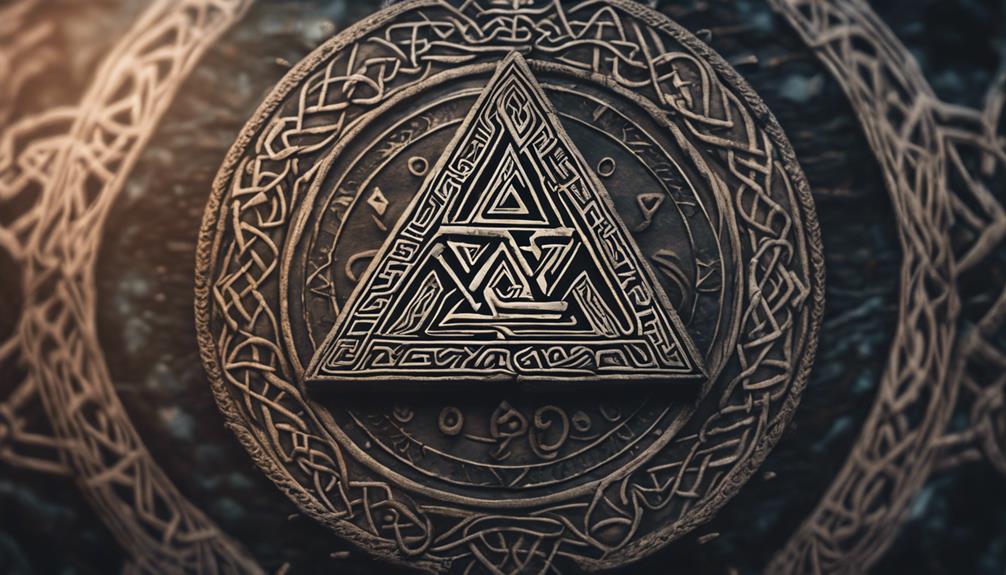
Uncovering Norse symbols reveals ancient wisdom and valor. The **Valknut** shows fallen warriors and ties to the divine. **Mjölnir** stands for warrior spirit and God’s favor, even through Christian times. The **Helm of Awe** evokes fear in foes and empowers warriors in battle. The **Norse Compass** guides through life’s thicket, while **Yggdrasil** is the tree of cosmic order and connections. These symbols **protect, strengthen,** and **embolden** people. Learn these emblems for deeper historical and spiritual insights. Dive in to understand these timeless symbols!
Key Takeaways
- Valknut symbolizes fallen warriors and connection to Odin, embodying courage and strength.
- Mjölnir represents warrior spirit, strength, and divine favor, remaining a symbol of protection.
- Helm of Awe features eight arms, instilling fear in enemies and granting courage in battle.
- Norse Compass (Vegvisir) guides and protects travelers through challenges, aiding in navigation.
- Yggdrasil symbolizes cosmic order, unity, and balance, safeguarding life's continuity and interconnectedness.
Symbol of Valhallas Warriors
Symbolizing the fallen warriors and their ties to Odin in Norse mythology, the Valknut holds significant meaning in the Viking culture. This powerful symbol, often associated with slain warriors, represents the connection between the mortal sphere and the divine. Found in Viking tombs, the Valknut signifies the cyclical nature of life, death, and rebirth, reflecting the valor and heroism of those who've fallen in battle. With its three interlocking triangles, the symbol also represents the nine worlds in Norse cosmology, embodying the courage, strength, and protection sought by warriors in times of conflict.
The Valknut's association with Odin, the Allfather and ruler of Asgard, further enhances its significance as a symbol of honor and sacrifice among Valhalla's warriors. Those who wear or display the Valknut signal their allegiance to Odin and their readiness to embrace their fate on the battlefield. As a emblem of bravery and resilience, the Valknut serves as a reminder of the warrior spirit that resonates deeply within the Viking culture.
Thors Hammer of Protection
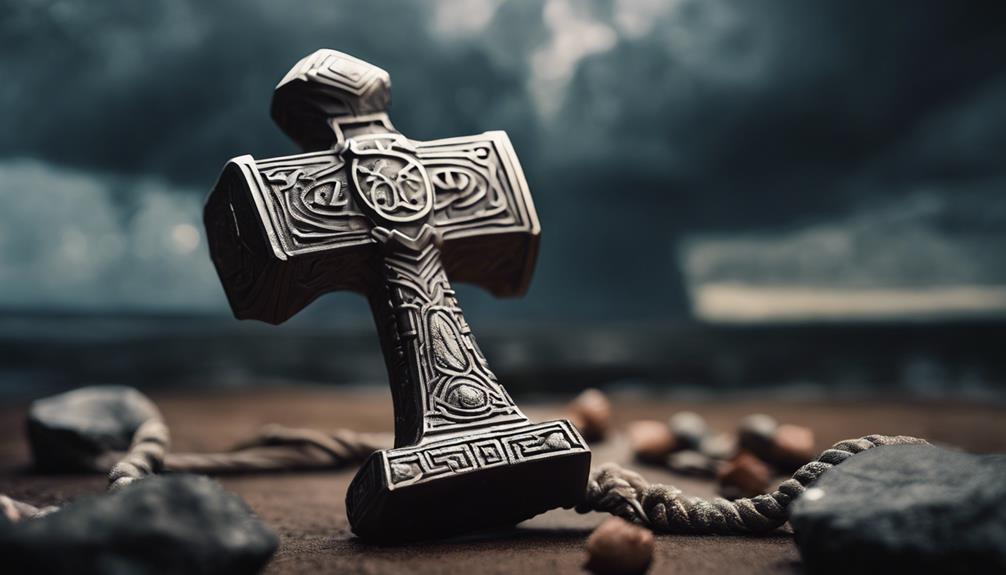
Thors Hammer, or Mjölnir, serves as a potent symbol of protection in Norse mythology. Associated with Thor, the god of thunder and strength, Mjölnir was believed to offer both physical and spiritual defense.
Its historical origins and symbolic power make it a fascinating subject to explore.
Symbolic Power of Mjölnir
With its roots deep in Norse mythology, Mjölnir, known as Thor's hammer, embodies the essence of thunder, lightning, and protective strength. Here are three fascinating aspects of the symbolic power of Mjölnir:
- Warrior Symbol: Mjölnir is more than just a hammer; it represents the warrior spirit and the strength to overcome challenges.
- Archaeological Significance: Found in various archaeological sites, Mjölnir's presence showcases its importance in Norse culture and history.
- Continued Relevance: Despite the shift to Christianity, Mjölnir remained a symbol of protection, with people using it for rituals and as a protective amulet.
Historical Origins Explored
Exploring the historical origins of Mjölnir reveals its significance as a powerful symbol of protection in Norse mythology. Thors Hammer, also known as Mjölnir, was utilized by the thunder god Thor to safeguard Asgard and Midgard from adversaries.
Crafted with magical properties, Mjölnir wasn't just a weapon but a symbol of strength, courage, and divine favor. This powerful symbol was believed to defend against malevolent forces and bestow blessings upon those under its protection.
The intricate design of Thors Hammer symbolizes more than just physical might; it represents the authority and guardianship of Thor in Norse culture. As a popular protective emblem, Mjölnir stands as a testimony to the enduring legacy of Thor's hammer as a symbol of protection and strength.
Helm of Awe
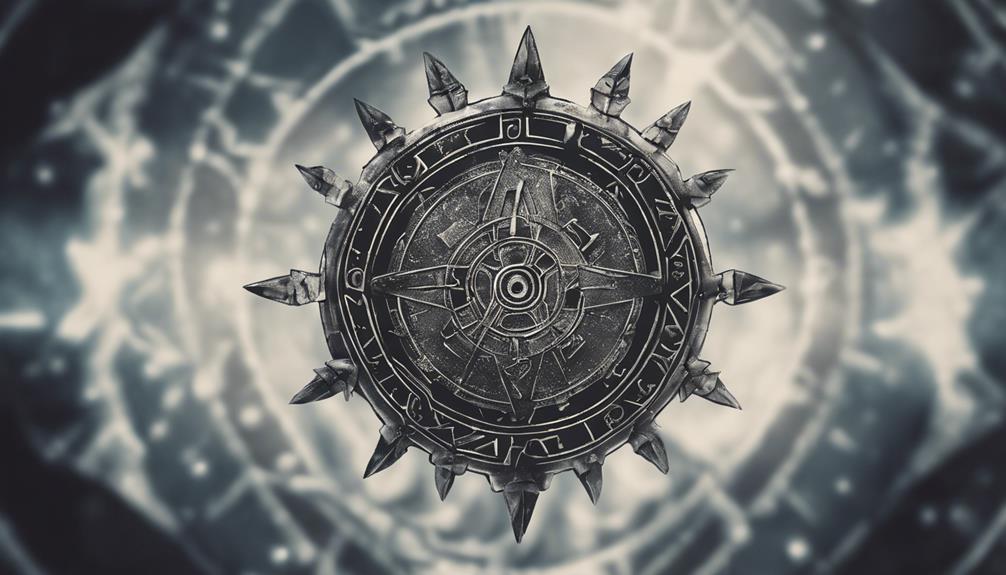
The Helm of Awe, known as Ægishjálmr, serves as a potent protective symbol deeply rooted in Norse mythology. When exploring this Norse symbol, we uncover its fascinating attributes:
- Symbolic Design: The Helm of Awe features eight arms radiating from a central point, symbolizing protection and strength. This intricate design isn't just visually enthralling but also holds deep meaning for those who embrace its power.
- Warrior's Courage: Warriors of the past believed that wearing the Helm of Awe would instill fear in enemies and grant them courage in battle. It served as a talisman of protection, empowering them for the challenges they faced on the battlefield.
- Connection to Odin: Associated with the Norse god Odin, the Helm of Awe was revered for its dual purpose in physical and spiritual defense. Its ties to such a prominent figure in Norse mythology added to its mystique and significance among believers.
The Helm of Awe stands as a powerful symbol of protection and courage, resonating with those seeking strength in the face of adversity.
The Norse Compass
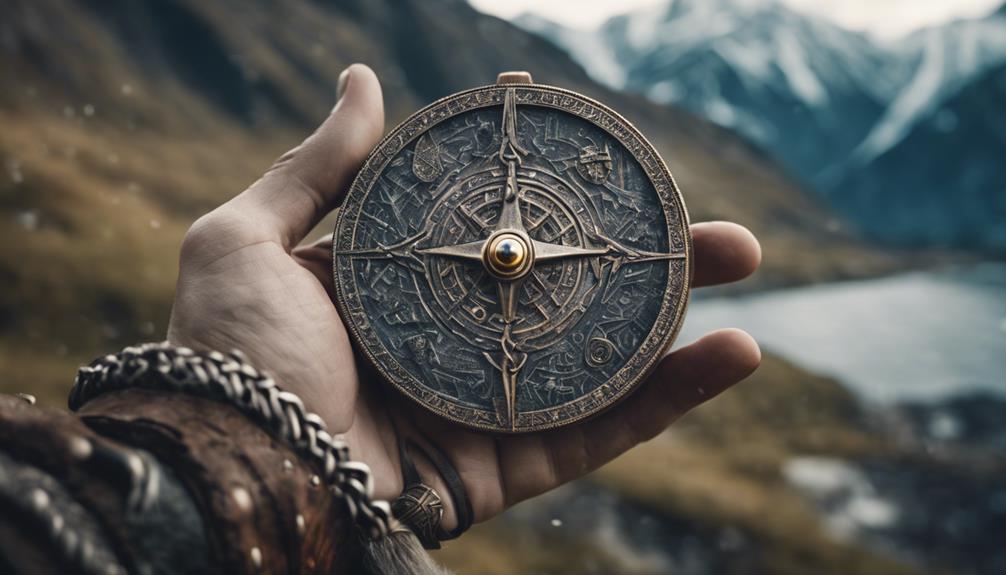
Exploring through the vast seas of Norse mythology, one encounters the Norse compass, a symbol of guidance and protection known as Vegvisir. Vegvisir features eight arms radiating from a central point, providing aid to travelers through challenges and rough waters. Believed to help individuals find their path and navigate through life's obstacles, Norse people trusted Vegvisir to lead them safely on physical and spiritual journeys. This symbol emphasizes the importance of finding direction and protection amidst life's uncertainties.
| Symbol | Meaning | Emotion |
|---|---|---|
| Vegvisir | Guidance | Hopeful |
| Compass | Direction | Focused |
| Protection | Safety | Secure |
The Norse compass, with its intricate design and profound symbolism, serves as a beacon of hope and focus for those seeking guidance and protection. As we investigate the mysteries of Norse mythology, the Vegvisir stands out as a powerful reminder to stay on course and find security in the midst of life's challenges.
The World Tree of Protection
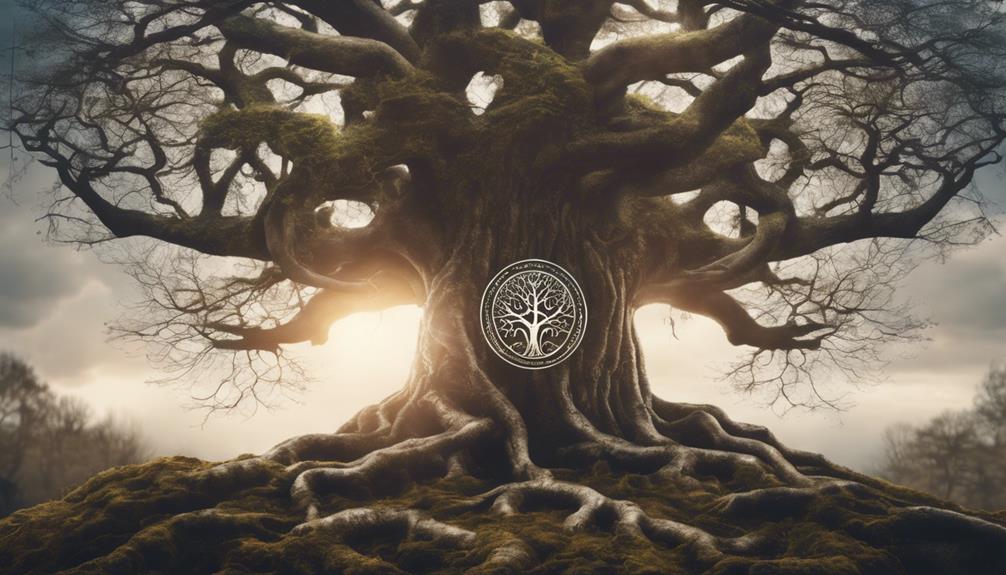
Yggdrasil, the World Tree, stands as a powerful symbol of protection and interconnectedness in Norse mythology. Its roots signify a strong foundation of security, while its branches provide support and guidance.
Understanding the symbolism behind Yggdrasil sheds light on the deep spiritual significance and cosmic order it represents.
Yggdrasil Symbolism Explained
Symbolizing cosmic order and the eternal cycle of life, death, and rebirth, the World Tree Yggdrasil stands as a guardian of youth, harmony, and destiny in Norse mythology. Here are three intriguing aspects of Yggdrasil's symbolism:
- Nine Domain Connection: Yggdrasil serves as the cosmic link between the nine domains of the Nordic universe, emphasizing interconnectedness and unity.
- Axis Mundi Representation: Believed to be an axis mundi, Yggdrasil acts as a bridge between the physical and spiritual domains, symbolizing divine connection and balance.
- Protector of Fate: As the World Tree, Yggdrasil safeguards the threads of fate, ensuring the harmony and continuity of life's intricate tapestry.
The symbolism of Yggdrasil offers a fascinating insight into Norse beliefs and the interconnected nature of existence.
Roots of Protection Symbol
The roots of the World Tree of Protection in Norse mythology extend deeply into different domains, anchoring the universe and symbolizing stability and safeguarding. Yggdrasil, as the protective symbol it represents, showcases the interconnectedness of all things in the cosmos.
These roots not only provide a firm foundation for the universe but also embody the essence of protection and resilience. In Norse belief, Yggdrasil's roots signify the essential role of interconnectedness in maintaining balance and order within the domains.
As we explore the roots of Yggdrasil, we uncover a profound connection to the concept of protection, highlighting the tree's significance in preserving the harmony and cosmic order that define the Norse worldview.
Branches of Support Symbol
With its majestic branches stretching far and wide, the World Tree of Protection stands as a symbol of interconnection and support in Norse mythology. Yggdrasil, the mighty World Tree:
- Symbolizes the cosmic order and the interconnectedness of all things, embodying the harmony and balance of the natural world.
- Serves as a central axis linking the nine domains of the Norse universe, providing continuity and representing the cycle of life.
- Offers support for gods, humans, and creatures alike, showcasing the belief in unity and solidarity within the cosmos.
Yggdrasil's branches not only connect beings but also reinforce the idea of mutual dependence and shared destiny in the Norse mythological framework.
Symbol of Protection From Harm
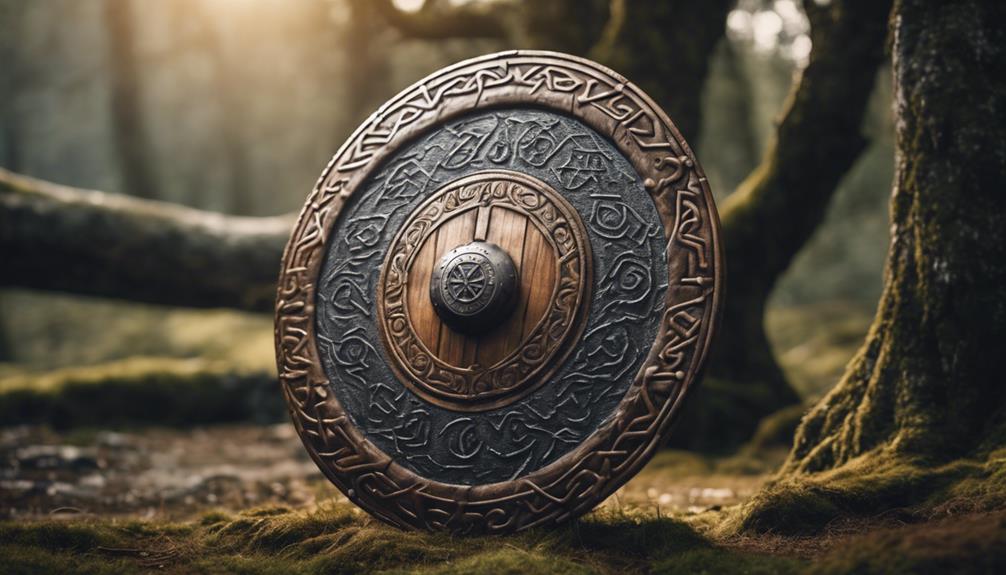
In Norse mythology, protection from harm is embodied by the formidable Helm of Awe symbol. The Viking warriors wore this symbol as a source of courage and defense against physical and spiritual threats. It was believed that wearing the Helm of Awe granted the wearer the strength and protection of Thor himself, especially in times of peril. This symbol wasn't only a shield against external dangers but also a source of inner strength, warding off evil forces and instilling bravery in those who bore it.
Carved onto weapons and shields, the Helm of Awe was a powerful emblem that enhanced protection in battle for the Norse people. Its intricate design and symbolic meaning made it a potent symbol of security and fortitude. The Helm of Awe remains a cherished representation of safeguarding against harm, inspiring those who seek protection and courage in the face of adversity.
Frequently Asked Questions
What Is the Most Powerful Norse Symbol?
The most powerful Norse symbol is often considered to be Mjölnir, Thor's iconic hammer, representing strength, protection, and divine favor. Wielded by Thor, the god of thunder, it defends Asgard and the worlds from various threats.
Associated with fertility, courage, and the ability to channel Thor's power, Mjölnir is a potent emblem of protection, blessing marriages, consecrating oaths, and providing strength in battle against enemies.
Its significance in Norse mythology inspires strength and resilience.
What Do the Norse Symbols Mean?
When exploring Norse symbols, it's fascinating to uncover their deep meanings. Each symbol carries unique significance, such as the Valknut symbolizing life, death, and rebirth.
Mjölnir represents fertility and strength. The Aegishjalmr instills fear in enemies while offering protection. The Vegvisir guides travelers through rough waters.
The Helm of Thor symbolizes protection in battle. These symbols embody courage, strength, and protection, enriching Norse mythology with their powerful meanings.
What Is the Old Norse Magical Symbol?
We've discovered that the old Norse magical symbol is called Vegvisir. This powerful symbol serves as a guide and protector, especially during sea voyages.
With its eight arms resembling a compass, it aids travelers in steering through challenges. Rooted in Norse mythology, Vegvisir helps individuals find their way through spiritual journeys.
Vikings used this symbol to stay on track even in the toughest situations, providing a sense of security and direction in uncertain times.
What Is the Norse Symbol for Protection?
The Norse symbol for protection is a powerful representation of defense. It encompasses various symbols like the Valknut, Mjölnir, Aegishjalmr, Vegvisir, and Yggdrasil, each offering unique forms of protection against evil.
These symbols hold deep meaning in Norse mythology, providing courage, strength, and guidance to those who seek protection. From warding off threats in battle to safeguarding travelers on their journeys, these symbols embody the essence of protection in Norse culture.
What is the significance of Norse symbols in spiritual alchemy?
Norse symbols have deep spiritual alchemy symbols meanings. They hold power in unlocking the transformative energies of the universe. The significance lies in their ability to guide the seeker towards enlightenment and inner transformation. By understanding and harnessing these symbols, one can tap into the spiritual alchemy within themselves.
Conclusion
As we unravel the ancient Norse symbols and their powerful meanings, one thing is clear – there's a rich history and deep significance behind each of these symbols.
But what secrets do these symbols still hold? What untold stories lie within their intricate designs?
Only time will reveal the full extent of their power and mysteries. Keep exploring, keep learning, and who knows what other hidden truths you may uncover.
Robert, Research Specialist—Robert specializes in visual explorations and brings a keen eye for detail to our research team. He delves into the historical and cultural backgrounds of symbols to present deeply researched content beautifully, making the old and mystical accessible to a modern audience.
Cultural and Historical Symbols
What Polynesian Symbols for Strength and Their Meanings?
Journey through Polynesian culture's symbols for strength like sharks, turtles, and tiki figures, each carrying profound meanings waiting to be unraveled.
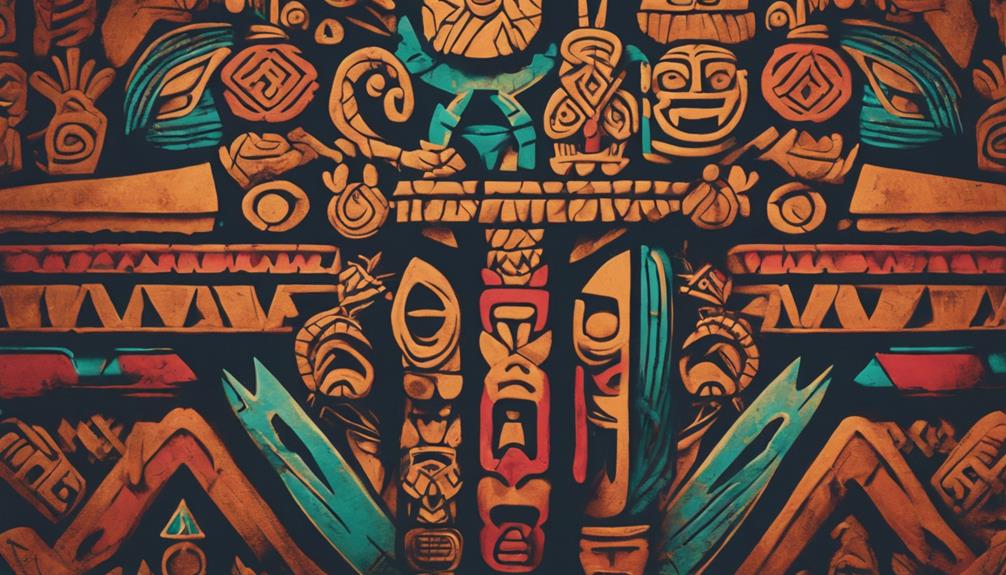
In Polynesian culture, symbols like **sharks** mean resilience, turtles stand for strength, and tiki figures show courage. Shark teeth tattoos tell tales of determination and fearlessness. Turtles show resilience, wisdom, and protection, with shell patterns symbolizing strength and endurance. Tiki figures represent courage, protection, and spiritual importance. These symbols express deep meanings of fortitude and endurance in Polynesian society, painting a beautiful picture of strength and inner power. Each symbol tells a unique story of resilience, reflecting the rich heritage of Polynesia.
Key Takeaways
- Shark symbolizes resilience, power, and courage in Polynesian culture.
- Turtle represents strength, wisdom, and protection, embodying resilience and longevity.
- Tiki figures symbolize courage, protection, and spiritual significance in Polynesian tradition.
- Guardian Turtle signifies wisdom, stability, and strength as a protector of the ocean.
- Shark and turtle symbols in tattoos convey inner strength, endurance, and ancestral resilience.
Shark Symbol for Strength
Exploring the significance of the Shark Symbol for Strength reveals its deep-rooted connection to resilience and power in Polynesian culture. In Polynesian art, shark teeth are a prominent element, symbolizing not only strength but also adaptability and courage. The intricate designs of shark teeth in Polynesian tattoos convey a sense of determination and fearlessness, capturing the essence of these powerful creatures. The use of shark teeth in tattoos signifies guidance and ferocity, traits highly valued in Polynesian society.
The stylized representation of shark teeth in Polynesian designs showcases the reverence for the strength and tenacity of sharks, inspiring individuals to embody these qualities. The incorporation of shark teeth in tattoos serves as a reminder of the importance of resilience and the ability to navigate challenges with unwavering determination. Through the symbolism of shark teeth, Polynesian culture emphasizes the significance of inner strength and the relentless pursuit of goals.
Turtle Symbol for Resilience
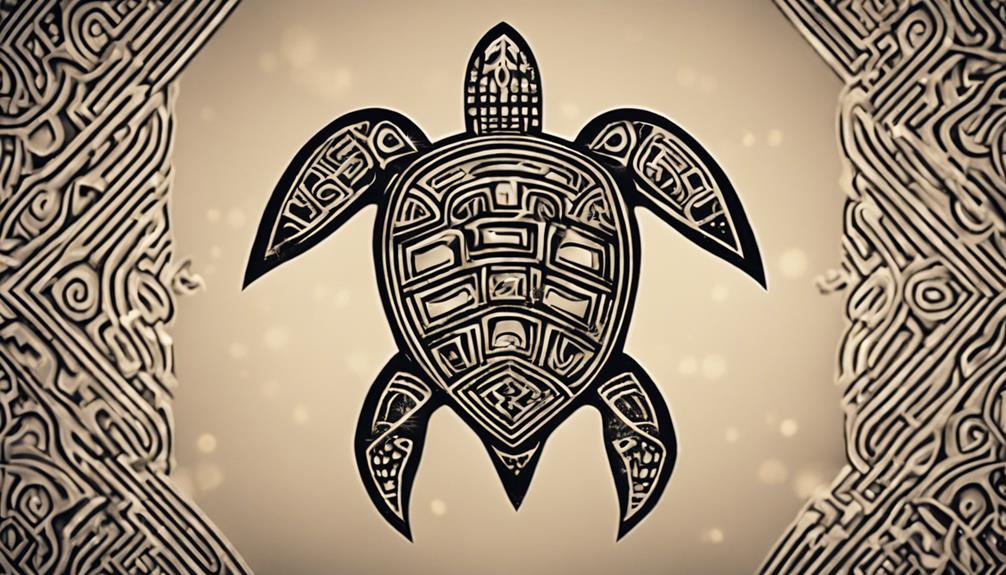
The turtle symbol in Polynesian culture carries deep meanings of resilience, wisdom, and protection. It represents the ability to withstand challenges and adapt to different circumstances, embodying inner strength and endurance.
Through intricate shell patterns and spiritual significance, turtles in Polynesian art symbolize the journey of life and the connection to the vast ocean.
Turtle Shell Symbolism
Symbolizing resilience and strength, the turtle shell holds deep cultural significance in Polynesian tattoo art. Representing protection and longevity, this symbol signifies the ability to navigate life's challenges with perseverance.
Polynesian cultures revere the turtle as a sacred creature with profound spiritual meaning. The intricate patterns within the turtle shell design symbolize the interconnectedness of life and nature.
Ocean Connection Representation
Incorporating the turtle symbol in Polynesian culture highlights the enduring connection to the ocean and the resilience it represents. The turtle embodies a profound link to the sea, symbolizing the intertwined relationship between Polynesian communities and the vast waters that surround them.
This connection emphasizes the importance of endurance, as turtles navigate the ocean with grace and strength. The symbolism of protection also resonates deeply, with turtles being revered for their ability to shield and guide.
Through intricate shell patterns, Polynesian art showcases the turtle's significance in representing strength, stability, and adaptability in the face of challenges. The turtle's presence in Polynesian tattoos not only embodies resilience but also signifies unity, family, and the journey of life.
Cultural Significance Explanation
How does the turtle symbol in Polynesian culture encapsulate the essence of resilience and endurance within the community's beliefs and values?
The turtle symbolizes resilience in Polynesian culture through its representation of longevity, protection, and the ability to navigate challenges. Polynesian tattoos featuring turtles convey strength and perseverance, reflecting the community's belief in overcoming obstacles. Associated with the enduring nature of the ocean, turtles embody the interconnectedness of life in Polynesian beliefs.
The turtle's significance lies in its adaptability and inner strength when facing life's hardships. In Polynesian art, the turtle motif serves as a reminder of the importance of patience and stability in achieving one's goals, reinforcing the cultural values of resilience and perseverance.
Tiki Figures Representing Courage

Tiki figures hold a special place in Polynesian culture as symbols of courage and protection. These intricate designs with exaggerated features embody strength and spiritual energy, serving as guardians of inner resilience.
Through traditional carvings, art, and tattoos, Tiki figures convey a deep connection to bravery and guidance in maneuvering life's challenges.
Tiki Symbolism Explained
Crafting symbols of courage and strength, Tiki figures in Polynesian culture embody protective and spiritual significance. These figures, often depicting ancestors guarding their descendants, symbolize strength and bravery in the face of adversity.
The intricate carvings of Tiki statues convey a sense of power and resilience, reflecting the rich cultural heritage of the Polynesian people. Tiki symbols are also integrated into Polynesian tattoo designs, where they serve as potent representations of courage and spiritual connection.
Each Tiki carving holds unique meanings, showcasing the diverse aspects of protection and strength within Polynesian beliefs. Through their artistry and symbolism, Tiki figures stand as enduring icons of courage and fortitude in Polynesian communities, reminding us of the importance of bravery in facing life's challenges.
Cultural Significance of Tiki
In exploring the cultural significance of Tiki figures, we uncover their profound representation of courage and fortitude in Polynesian heritage. Tiki figures, deeply rooted in Polynesian culture, symbolize protection, strength, and bravery. These carvings aren't mere artworks but embodiments of deities or ancestors, carrying spiritual power and guidance.
Intricately detailed Tiki designs are prevalent in Polynesian tattoos, serving as a link to tradition and heritage. Within Polynesian belief systems, Tiki symbols also convey fertility, creativity, and the essence of life itself. The variations in Tiki figures reflect different facets of strength and resilience, illustrating the rich tapestry of Polynesian art.
Embracing a Tiki figure can instill a sense of courage and determination drawn from the depths of Polynesian symbolism.
Traditional Tiki Designs
With their striking features and intricate details, traditional Polynesian Tiki designs embody profound symbols of courage and strength. These figures represent a fusion of protection, inner power, and spiritual resilience in Polynesian cultures. Tiki symbols, often adorned with large eyes and fierce expressions, symbolize guardianship against evil forces while invoking a sense of bravery in the wearer. The marriage of strength and marriage echoes through the detailed craftsmanship of Tiki designs, conveying ancestral connections and cultural significance. These intricate patterns are not merely decorative but hold deep-rooted meanings that inspire courage and resilience. The incorporation of Tiki figures into Polynesian tattoo art further enhances the representation of bravery and the ability to overcome challenges.
| Symbols | Meanings |
|---|---|
| Protection | Guarding against evil spirits |
| Inner Power | Invoking bravery and resilience |
| Cultural | Conveying ancestral connections |
Polynesian Shark Symbolism
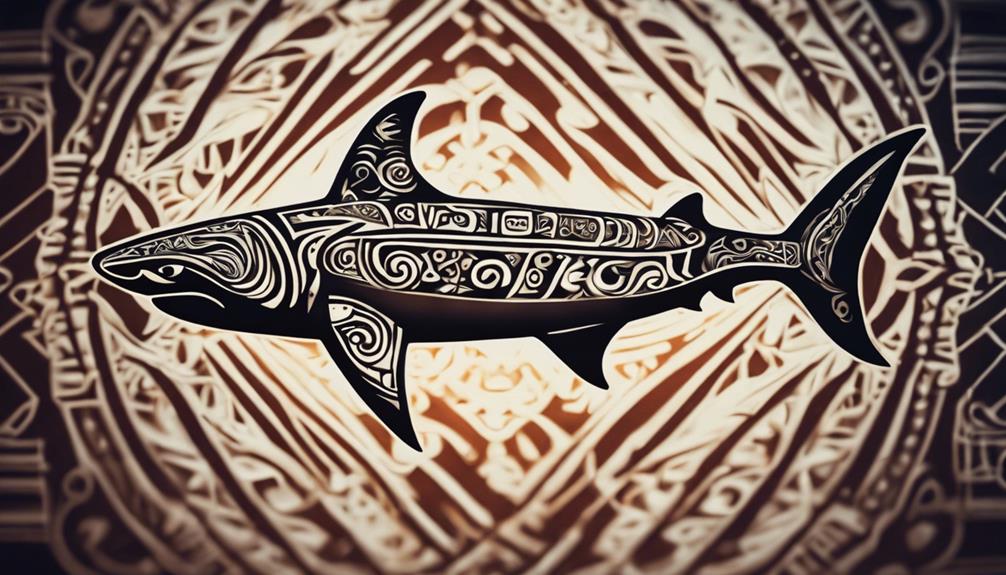
Shark teeth symbolize strength, adaptability, and power in Polynesian culture, often depicted in tattoos to convey courage and resilience. Sharks, revered for their ferocity and guidance qualities, hold significant symbolism in Polynesian traditions.
Here are some insights into Polynesian Shark Symbolism:
- The stylized shark tooth symbol can be depicted singly or in pairs in Polynesian tattoos.
- Shark teeth designs are a prominent motif in Polynesian tattoo art, symbolizing courage.
- Polynesian tattoos often feature shark teeth designs to convey attributes of strength and resilience.
- Sharks are seen as powerful creatures embodying the essence of strength and adaptability.
- The representation of shark teeth in Polynesian culture reflects the belief in overcoming challenges with bravery and fortitude, making it a popular choice in tattoo designs to evoke these qualities.
Turtle Symbolism in Polynesian Culture
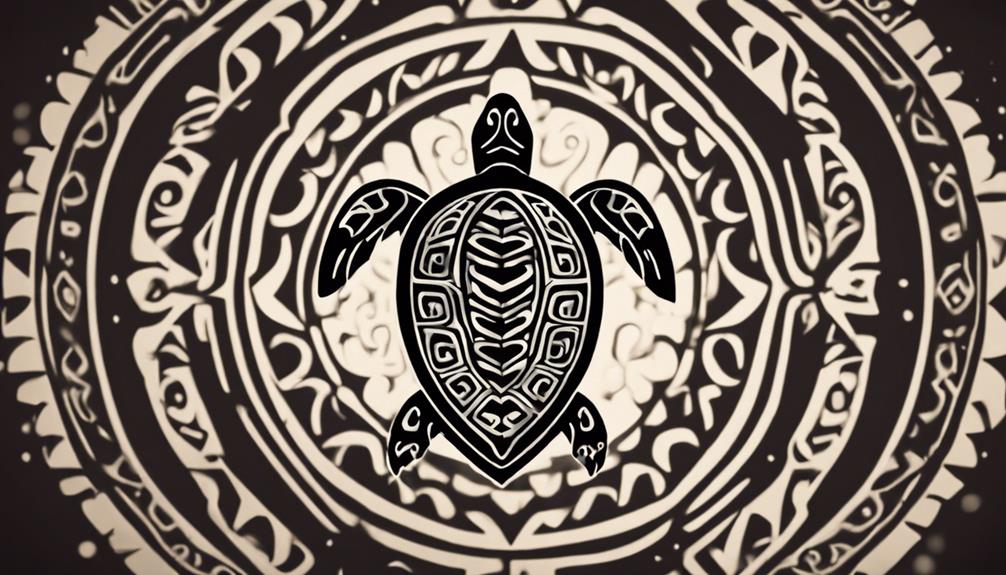
The turtle holds significant meaning in Polynesian culture, symbolizing longevity, peace, and harmony with nature.
Associated with navigation and protection, the turtle embodies the spirit of the ocean and resilience in the face of challenges.
Its shell is revered for representing strength, protection, and the cycle of life, embodying wisdom and adaptation in Polynesian traditions.
Turtle as a Guardian
How do Polynesians view the turtle as a guardian symbol in their culture?
Turtles hold significant symbolism in Polynesian culture, embodying protection, longevity, and guidance. Here are some key aspects of the turtle as a guardian:
- Protector of the Ocean: Turtles are revered as guardians of the ocean, symbolizing resilience and strength.
- Symbol of Resilience: The turtle represents the ability to overcome challenges and adapt to various situations.
- Connection to Nature: Polynesians view the turtle as a symbol of their deep connection to nature and the environment.
- Wisdom and Stability: The turtle's presence in Polynesian art signifies wisdom, stability, and maneuvering life's obstacles.
- Embodiment of Strength: In tattoos and art, turtles are depicted with intricate designs, showcasing their symbolic strength and protective nature.
Turtle Shell Strength
Symbolizing strength and protection in Polynesian culture, turtle shells hold significant meaning as enduring emblems of resilience and fortitude. The turtle, with its association with longevity and endurance, is a powerful symbol of strength in Polynesian symbolism.
The intricate patterns of turtle shells in tattoos not only represent stability and security but also a deep connection to nature. Polynesian tribal designs often incorporate turtle motifs to convey inner strength and perseverance.
The turtle shell, a symbol of defense and fortitude, is highly regarded in Polynesian art and tattoos for its representation of unwavering strength. Embracing the symbolism of the turtle shell is a way to invoke the essence of endurance and protection in the face of challenges, reflecting the rich cultural heritage of Polynesian symbols for strength.
Tiki Figures and Ancestral Strength
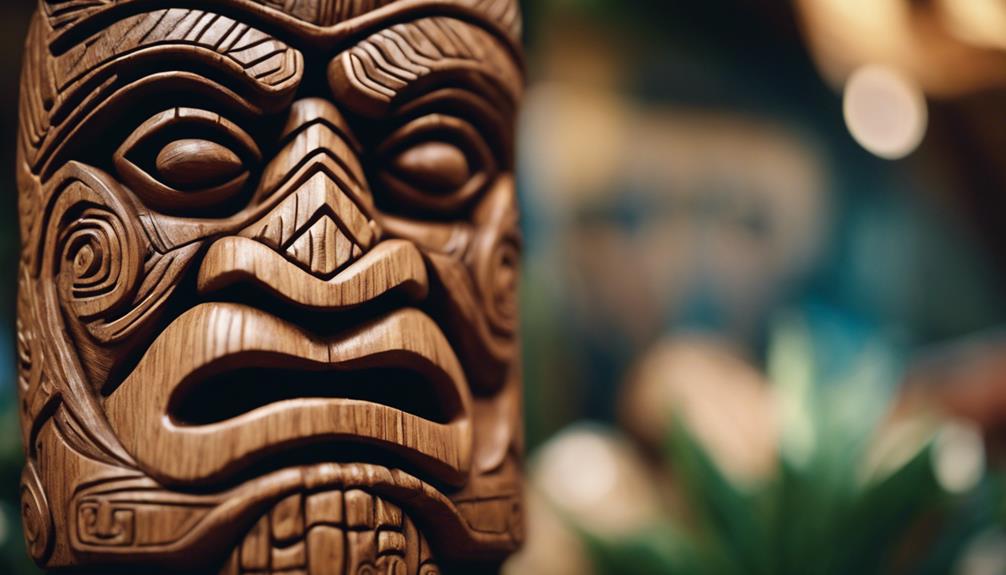
Embodying the essence of ancestral resilience and spiritual guardianship, Tiki figures hold a significant place in Polynesian culture. These iconic symbols carry profound meanings related to ancestral strength, protection, and connection to spirits. Here are some intriguing insights about Tiki figures:
- Tiki designs often symbolize deities or ancestors, representing power, wisdom, and guardianship.
- Tiki tattoos are believed to bring luck, courage, and guidance, reflecting Polynesian beliefs in spiritual protection.
- The intricate details and facial expressions of Tiki figures convey different aspects of strength, resilience, and heritage.
- Tiki symbols are commonly used in Polynesian tattoo art to honor the strength and legacy of ancestors, enhancing the wearer's connection to their roots.
- Through their intricate designs and spiritual significance, Tiki figures serve as timeless reminders of the enduring strength and protective influence of ancestral spirits in Polynesian culture.
Meaning of Shark Symbols in Polynesia
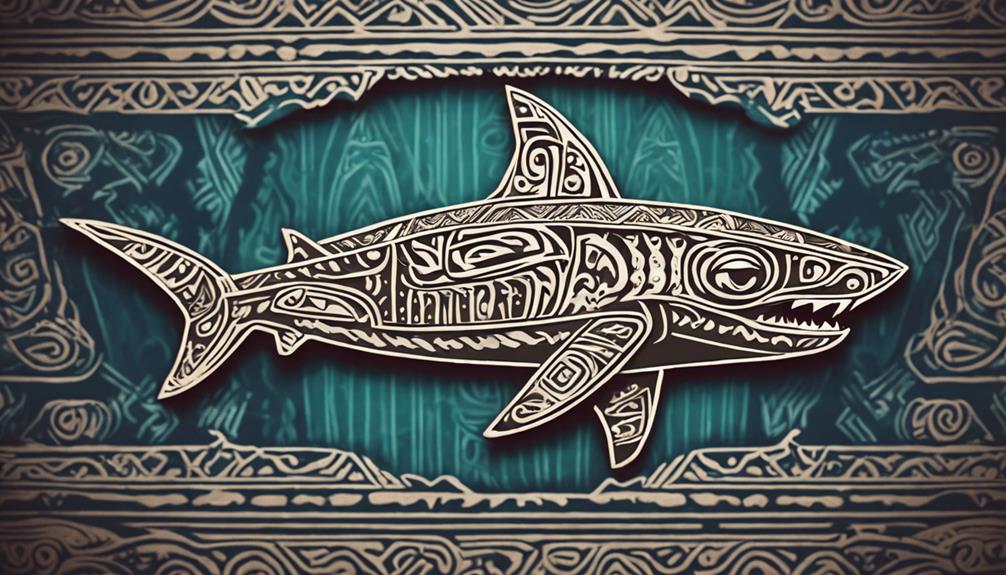
Shark symbols in Polynesia convey strength, adaptability, and power in traditional tattoo art. The depiction of shark teeth in Polynesian tattoo designs holds significant meaning, with single or double stylized teeth symbolizing different aspects of strength and resilience.
These symbols aren't merely decorative but serve as representations of courage and guidance in the intricate world of Polynesian tattoos. The incorporation of shark teeth in these designs showcases ferocity and resilience, reflecting the inner strength of the wearer.
Polynesian tattoo art is deeply rooted in cultural significance, with each design element carefully chosen to convey specific messages. The inclusion of shark symbols in these tattoos adds layers of meaning, highlighting the wearer's ability to navigate challenges with power and adaptability.
Embracing the essence of the shark in Polynesian tattoo art is a powerful statement of strength and determination, honoring the rich symbolism of this formidable creature.
Turtle Symbolism for Endurance
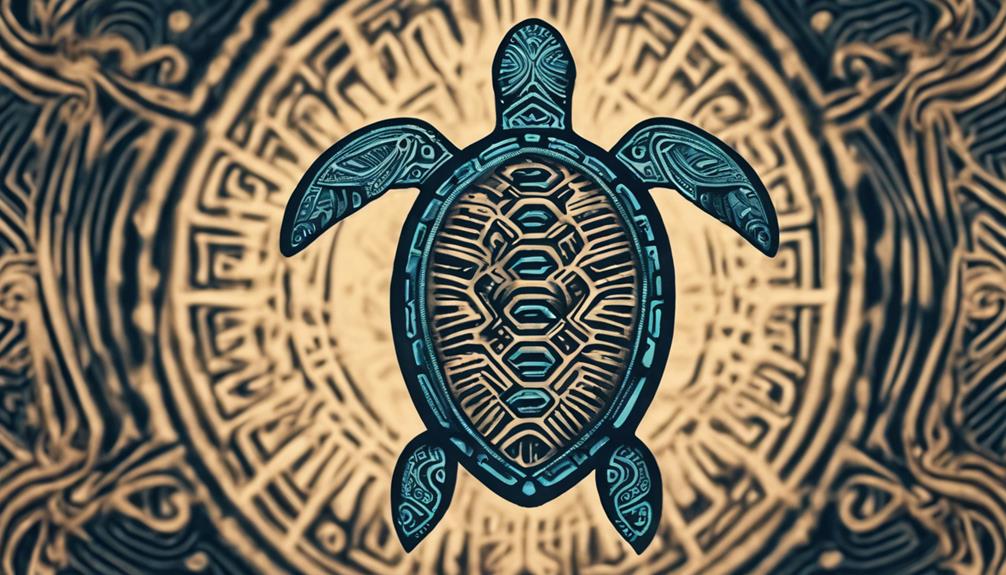
In Polynesian culture, the turtle symbol holds significant meaning, representing endurance, longevity, and protection. The symbolism of the turtle in Polynesian tradition goes beyond its physical characteristics, embodying profound concepts that resonate with the values of the Polynesian people. Here are some key points about the turtle symbolism for endurance:
- Turtles are associated with the ocean and signify harmony with nature and the environment.
- In Polynesian tattoo art, the turtle symbol is used to represent resilience, stability, and the ability to navigate through life's challenges.
- The turtle shell pattern is a common motif in Polynesian tattoos, symbolizing strength, wisdom, and guidance.
- Polynesian legends often depict turtles as revered creatures embodying steadfastness and inner strength.
- Additionally, the turtle symbol can also represent overcoming obstacles and emerging victorious, showcasing the indomitable spirit of the Polynesian people.
Tiki Figures and Divine Protection
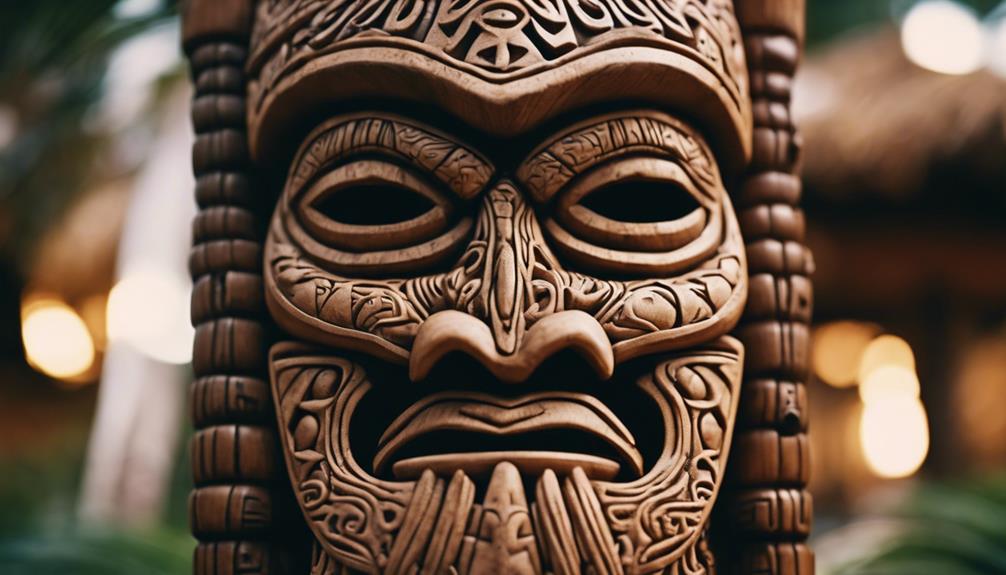
Tiki figures in Polynesian culture symbolize divine protection, power, and a strong connection to ancestral spirits or gods. These intricate designs, often seen with exaggerated facial features, hold deep meanings related to safeguarding against harm and evoking spiritual strength. The use of Tiki symbols in Polynesian tattoos is a way to channel courage, resilience, and guidance from the divine domain. The details within Tiki figures convey specific messages about protection and the ability to ward off malevolent forces.
In Polynesian mythology, Tiki symbols are intertwined with the concept of guardianship and mana, which is the spiritual energy believed to flow through all things. By incorporating Tiki figures into various aspects of life, Polynesians seek not only protection but also a profound connection to the divine forces that watch over them. The reverence for Tiki figures reflects a belief in the power they hold to shield and empower individuals in their daily lives.
Interpreting Polynesian Symbols for Strength
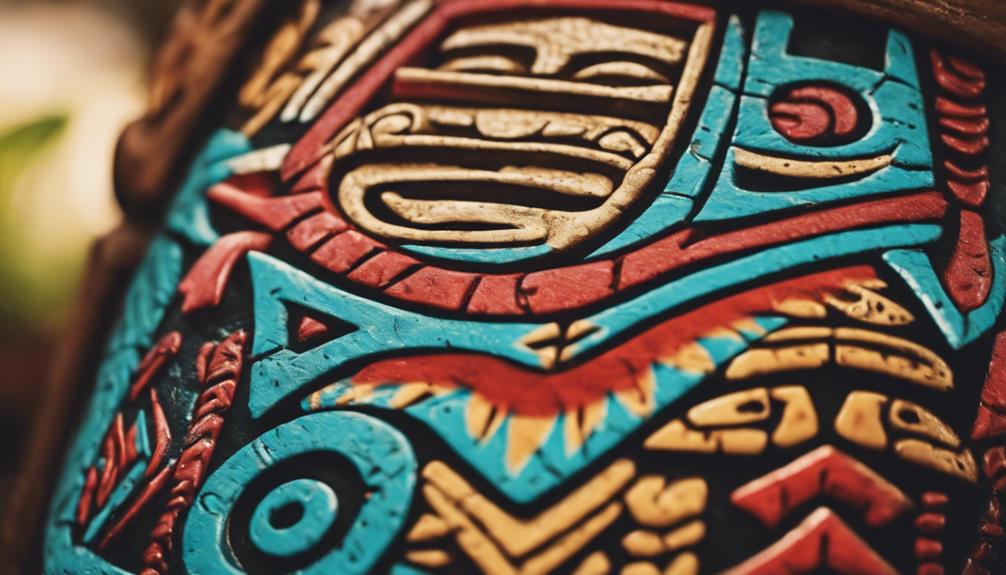
Exploring the intricate meanings behind Polynesian symbols for strength enhances our understanding of the cultural depth embedded in these ancient art forms. When investigating these symbols, we plunge into the essence of Polynesian heritage and values, uncovering the profound significance they hold. Here are some key insights:
- Shark Teeth Motifs: These motifs symbolize power, adaptability, and courage, reflecting the resilience and fearlessness valued in Polynesian culture.
- Incorporation into Polynesian Tattoos: The inclusion of shark teeth symbols in tattoos conveys traits such as strength, guidance, and protection, showcasing the individual's connection to their roots.
- Variations in Stylization: Whether single or doubled, the representation of shark teeth can carry different meanings of strength, adding layers of complexity to the symbolism.
- Intricate Design Patterns: Polynesian art uses elaborate patterns and symbolism to depict strength and ferocity, showcasing the artistry and storytelling prowess of its creators.
- Cultural Significance: Understanding the meanings behind these symbols not only enriches our appreciation for Polynesian tattoos but also deepens our respect for the cultural heritage they represent.
Frequently Asked Questions
What Is the Polynesian Symbol of Strength?
The Polynesian symbol of strength is often depicted with shark teeth, embodying qualities like adaptability, courage, and power. These symbols in Polynesian art signify resilience, determination, and the ability to overcome challenges.
Whether in single or doubled representations, shark teeth in tattoos emphasize different facets of strength. Incorporating these symbols reflects inner power, fortitude, and a warrior spirit.
The stylization of shark teeth in Polynesian designs showcases ferocity and guidance in various aspects.
What Is the Polynesian Warrior Symbol?
The Polynesian warrior symbol is called the 'Toa' in Maori culture. It's a powerful representation of strength, courage, and the warrior spirit in Polynesian tattoo art. The Toa symbol often features intricate designs and stylized elements, embodying the resilience and bravery of Polynesian warriors.
Their influence in the community was significant, with the Toa symbol serving as a reminder of their esteemed place in Polynesian culture.
What Is the Tribal Symbol for Strength and Courage?
In Polynesian culture, the tribal symbol for strength and courage is often represented by shark teeth. These symbols embody qualities like adaptability, guidance, and power.
Professional artists can create unique Polynesian tattoo designs featuring stylized shark teeth motifs to convey strength effectively. These intricate tattoos are known for their deep cultural significance and powerful symbolism, making them a popular choice for individuals seeking to showcase their inner strength and courage.
What Is the Hawaiian Symbol for Resilience?
We can explore the Hawaiian symbol for resilience, known as the 'Ama kua'. This symbol signifies strength, protection, and guidance, often depicted as a stylized triangle pointing upwards. It embodies the idea of overcoming challenges and maintaining inner strength during tough times.
The 'Ama kua' reflects the resilience ingrained in Hawaiian culture, symbolizing the ability to adapt and endure. Utilizing this symbol in tattoos or art conveys a powerful message of courage and perseverance.
What Are the Meanings of Polynesian Symbols for Strength Compared to Norse Symbols?
In the world of symbolism, the Polynesian symbols for strength carry a different significance compared to norse symbols meanings unveiled. The Polynesian symbols represent not only physical strength but also inner power and resilience. Meanwhile, the Norse symbols focus more on the warrior spirit and the ability to overcome challenges.
Conclusion
In Polynesian culture, symbols like the shark, turtle, and tiki figures represent strength, resilience, and courage. These symbols hold deep meanings and significance for the people of the Pacific Islands.
It's noteworthy that studies have shown that Polynesian tattoo designs incorporating these symbols are becoming increasingly popular in mainstream Western culture, reflecting a growing appreciation for the rich heritage and traditions of the Polynesian people.
Explore the power and beauty of these symbols to embrace strength in your own life.
Robert, Research Specialist—Robert specializes in visual explorations and brings a keen eye for detail to our research team. He delves into the historical and cultural backgrounds of symbols to present deeply researched content beautifully, making the old and mystical accessible to a modern audience.
Cultural and Historical Symbols
Revealing the Meaning of the Jack of Spades
Begin your journey into the world of cartomancy with the Jack of Spades, an enigmatic card symbolizing cleverness and wit, leaving you eager to uncover its deeper meanings.

**Unlocking the Secrets of the Jack of Spades** The Jack of Spades stands for cleverness, cunning, and smarts in card readings. This card means sharp thinking and staying alert, showing a mind as sharp as a tack. It’s all about a quick-witted, confident young man. Diving into its past shows how it adds depth to readings across cultures. Want to know more about this fascinating card? There are tons of hidden meanings ready to be found.
Key Takeaways
- The Jack of Spades symbolizes cleverness, cunning, and intelligence.
- Represents a clever young man with wit in cartomancy readings.
- Associated with strategic thinking and vigilance in symbolism.
- Offers detailed insights into various situations in cartomancy readings.
- Reflects changing values and beliefs over time in its historical evolution.
Origin of the Jack of Spades
The Jack of Spades, a key figure in traditional playing card decks, has its origins deeply rooted in the history of European card games. Playing cards have been a popular form of entertainment and divination for centuries, with each card holding its own unique symbolism and meaning in the art of cartomancy. The Jack of Spades, specifically, is associated with qualities such as cleverness, cunning, and intelligence. In European card games, this card has been a symbol of strategic thinking and wit, often representing a skillful and clever young man in cartomancy readings.
Throughout history, the Jack of Spades has held a significant place in the world of playing cards, intriguing players and fortune tellers alike with its mysterious allure. Its presence in the spades suit, which typically symbolizes intellect and challenges, adds depth to its interpretation in cartomancy. Understanding the origins and symbolism of the Jack of Spades can provide insight into its meanings in both playing card games and divination practices.
Symbolism and Interpretation
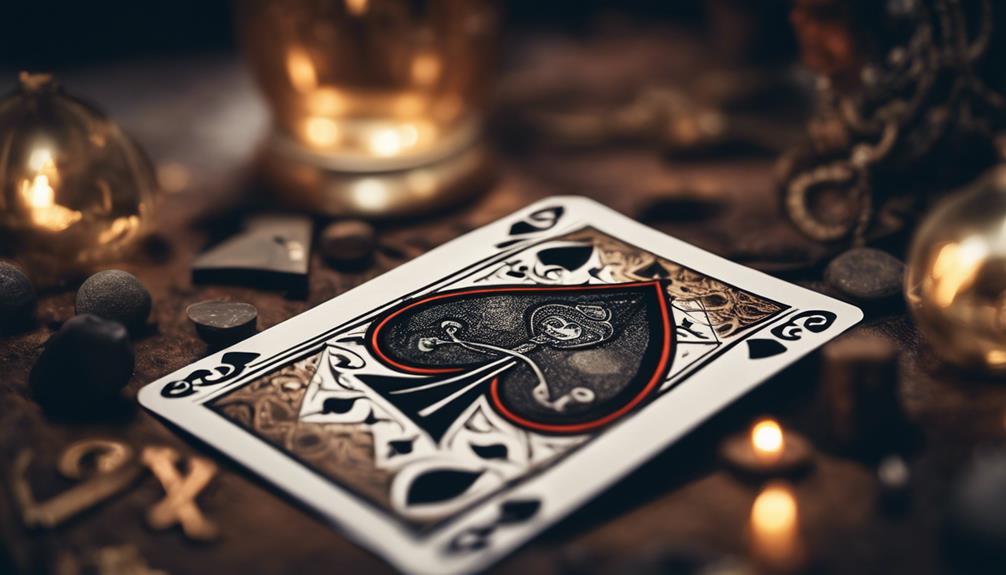
When exploring the symbolism and interpretation of the Jack of Spades, we'll look at Symbolic Imagery Analysis, Interpretation Through History, and Cultural Significance Exploration.
These points offer insights into the card's meanings across different contexts and time periods.
Symbolic Imagery Analysis
Exploring the symbolic imagery of the Jack of Spades reveals intricate layers of meaning in cartomancy readings. When delving into the interpretation of this card, we uncover its association with the dark side, shedding light on aspects of mystery and intrigue. Here are three key points to ponder:
- The Jack of Spades symbolizes a skillful and clever young man, often embodying characteristics of intelligence and cunning.
- In modern interpretations, this card is linked to themes of surveillance and observation, hinting at a vigilant and watchful presence.
- Card combinations involving the Jack of Spades can provide detailed insights into various situations, offering a deeper understanding of circumstances and individuals involved.
Understanding the symbolic imagery of this card can notably enhance the depth of cartomancy readings.
Interpretation Through History
Through centuries of cultural evolution, the symbolism and interpretation of the Jack of Spades have undergone significant transformations, reflecting the shifting values and beliefs of societies. In the table below, we illustrate the evolution of the Jack of Spades symbolism over time:
| Time Period | Symbolism |
|---|---|
| Traditional | Intelligence, cunning |
| 18th-19th Century | Assertiveness |
| Modern Era | Adaptability, wit |
Understanding the historical context of the Jack of Spades provides insight into its varied interpretations. As societies change, so too does the significance attributed to this card. Exploring these shifts enriches tarot and cartomancy readings, offering a deeper understanding of the card's meanings across different cultures and regions.
Cultural Significance Exploration
Delving into the cultural significance of the Jack of Spades reveals its rich symbolism and multifaceted interpretations in cartomancy. This card, symbolizing a skillful and clever young man, carries deep meanings in readings. Here are some key points to ponder:
- The Jack of Spades is associated with themes of surveillance and observation, hinting at vigilance and awareness in situations.
- Specific card combinations involving the Jack of Spades offer detailed insights into various aspects of life, providing nuanced perspectives.
- Modern interpretations emphasize attributes like intelligence and cunning, highlighting the card's relevance in contemporary readings.
Personality Traits Associated
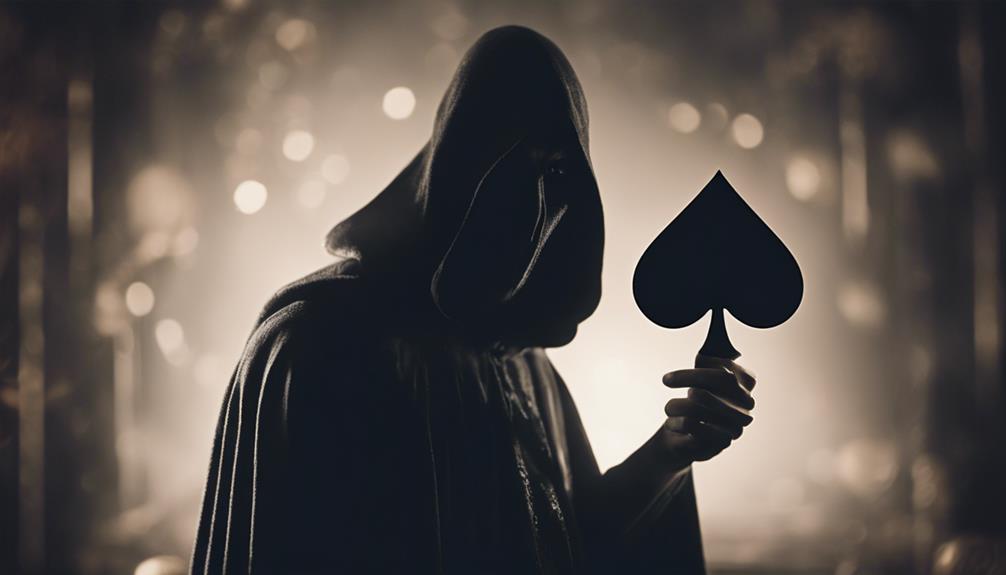
The Jack of Spades represents a clever and cunning individual with a sharp mind. This card signifies assertiveness, directness, and cleverness in personality traits.
People embodying the Jack of Spades energy are known for their observational skills and intelligence.
Traits of Jack
Assertive, direct, cunning, and clever are the defining personality traits associated with the Jack of Spades. This mysterious figure possesses a complex character that intrigues and challenges those around him. Here are some key traits that define the Jack of Spades:
- Strategic Thinking: The Jack of Spades is known for his ability to think several steps ahead, always planning his next move carefully.
- Resourcefulness: He can adapt to any situation, utilizing his surroundings and intellect to overcome obstacles.
- Confidence: His self-assurance borders on arrogance, stemming from a deep understanding of his capabilities and a knack for manipulation.
These qualities make the Jack of Spades a formidable and enigmatic character in the domain of playing cards.
Spades Symbolism
Moving from the traits of the Jack of Spades, we now explore the symbolism associated with the suit of Spades in relation to personality traits.
In cartomancy, Spades symbolize intellect, challenges, and mystery. Individuals with dark brown to black hair and eyes are often linked to the Suit of Spades. This suit represents qualities such as sharpness, analysis, and strategic thinking.
The Jack of Spades embodies cleverness, cunning, and a sharp mind, reflecting the essence of the Spades suit. Modern interpretations of Spades in cartomancy focus on surveillance, observation, and watching, highlighting the importance of keen perception and insight.
Embracing the Spades symbolism can help individuals cultivate their analytical abilities and navigate challenges with a sharp intellect.
Characteristic Interpretation
Exploring the Jack of Spades' characteristic interpretation reveals insights into the personality traits associated with this card in cartomancy readings.
- The Jack of Spades symbolizes a skillful and clever young man, embodying a balance between wisdom and hard work.
- Individuals linked to the Jack of Spades are often perceived as cunning and clever, known for their assertiveness and directness.
- Some interpretations suggest a hint of manipulation due to the intelligence attributed to this card.
Understanding these traits can provide valuable guidance when interpreting the Jack of Spades in readings, shedding light on the complexities and nuances of this card's symbolism in cartomancy.
Love and Relationships Insights

Exploring love and relationships can be enlightening when considering the insights associated with the Jack of Spades. In matters of the heart, this card symbolizes a partner who exudes assertiveness and dominance. When this energy is present, it may lead to a more controlling dynamic within relationships. For individuals who are single, it's important to establish strong boundaries when encountering someone represented by the Jack of Spades to maintain emotional safety. It's also wise to trust your intuition when dealing with the influence of this card in love readings.
When the Jack of Spades appears in relationship readings, it's essential to reflect on the nature of your attractions. Consider whether your feelings are genuine or if they're influenced by material benefits. This introspection can help you navigate potential challenges and make informed decisions about your romantic connections. Remember, emotional well-being should always be a priority when engaging with the energy of the Jack of Spades in matters of the heart.
Career and Success Revelations

With the Jack of Spades guiding career and success readings, a proactive approach to pursuing mentally stimulating paths is encouraged. To reveal the card's insights for career advancement, contemplate the following:
- Be Assertive and Proactive: Success may require taking charge of your career decisions, showing assertiveness, and being proactive in seeking opportunities rather than waiting for them to come to you.
- Continuous Learning: The Jack of Spades signals a time to ponder learning new skills or furthering your education by going back to school. This dedication to knowledge can open doors for career advancement.
- Focused Pursuit: Opportunities indicated by the card may demand focused pursuit and strategic planning. Stay sharp, remain focused on your career goals, and be prepared to put in the necessary effort for success.
Yes or No Divination Guidance

When utilizing yes or no divination guidance, it's important to focus on the decision at hand and avoid distractions. The Jack of Spades often signifies a yes answer in divination practices. Guidance with this card emphasizes the significance of staying focused on the current choice without letting other possibilities cloud the mind. By sticking with the chosen path, clarity can be achieved.
Seeking additional clarity through resources like cartomancy and tarot blogs can enhance one's understanding of the decision at hand. It's vital to trust the guidance provided by the Jack of Spades and maintain a clear mindset while seeking answers. Remember that the Jack of Spades offers valuable insights into yes or no questions, guiding individuals towards making informed decisions.
Frequently Asked Questions
What Is the Symbol for the Jack of Spades?
The symbol for the Jack of Spades is a young, clever man holding a sword with an orb attached. It signifies assertiveness, directness, and intelligence in cartomancy readings. Associated with the Suit of Spades, it represents intellect and mystery.
In tarot, the Jack of Spades corresponds to the Knight of Swords, emphasizing mental energy and communication. This symbol embodies a balance between wisdom and hard work, often seen as cunning and clever.
What Is the Jack of Spades Holding in His Hand?
We see the Jack of Spades holding a sword with an orb attached. The sword symbolizes assertiveness and cleverness, while the orb represents wisdom and hard work. Together, they showcase the Jack's power, intellect, and ability to open doors through intelligence and manipulation.
This combination signifies a balance between sharpness and observant nature. The sword and orb in his hand highlight his cunning and clever traits, reflecting a mix of wisdom and directness.
What Is the Jack of Spades Metasymbology?
The Jack of Spades metasymbology embodies a skillful and clever young man, symbolizing a blend of wisdom and hard work. It often hints at manipulation through intelligence and is characterized by keen observation and cleverness.
This card signifies assertiveness, directness, and cunning in cartomancy. Linked to the Knight of Swords tarot card, it emphasizes mental energy and proactive pursuit of opportunities.
The Jack of Spades is a powerful symbol of strategic thinking and resourcefulness.
What Does the Jack of Clubs Card Symbolize?
The Jack of Clubs card symbolizes a young man who's typically associated with creativity, ambition, and new beginnings in cartomancy. This card often represents someone who's enthusiastic, energetic, and ready to commence on new projects or ventures.
When this card appears in a reading, it can signify a period of growth, exploration, and taking action. The Jack of Clubs encourages us to embrace opportunities for personal development and to pursue our passions with determination.
What is the significance of the Jack of Spades in comparison to the Lion of Judah?
The Jack of Spades holds significance in card games, often associated with mystery and power. In comparison, the Lion of Judah carries deep spiritual meaning, symbolizing strength, royalty, and leadership. Both hold cultural and symbolic importance in different contexts, with the lion of judah meaning representing a more profound and sacred symbol.
Conclusion
To sum up, the Jack of Spades is a card that symbolizes determination, ambition, and intellect. Its origins date back to traditional playing card decks and have been associated with various interpretations over time.
Whether in love, career, or decision-making, the Jack of Spades encourages us to stay focused, think critically, and take calculated risks. So, next time you come across this card, remember its message of strength and strategic thinking to guide you on your path.
Boaz, Founder and Chief Editor – With a profound linguistics and anthropology background, founded What Does Meanings to explore the intricate connections between language, symbols, and cultural identity. His vision has guided the platform from its inception, ensuring that each piece of content enriches our understanding of the world’s symbolic heritage.
-

 Cultural and Historical Symbols2 months ago
Cultural and Historical Symbols2 months agoUnderstanding “What Does Eid Mubarak Mean”
-

 Modern Symbols and Signs1 month ago
Modern Symbols and Signs1 month agoSubaru's Dashboard Symbols Unraveled: 10 Meanings
-

 Cultural and Historical Symbols2 months ago
Cultural and Historical Symbols2 months agoExploring Crosses and Their Meanings in Depth
-

 Modern Symbols and Signs1 month ago
Modern Symbols and Signs1 month agoUnderstanding the Meaning of a Question Mark Road Sign
-

 Modern Symbols and Signs2 months ago
Modern Symbols and Signs2 months agoIs Five Guys Closing Permanently? The True Story
-

 Cultural and Historical Symbols4 weeks ago
Cultural and Historical Symbols4 weeks agoThe Cultural Insight of 'Pinche Gringo' Meaning
-

 Cultural and Historical Symbols4 weeks ago
Cultural and Historical Symbols4 weeks agoKing Abdulaziz University Blackboard Guide
-

 Linguistic Features and Figurative Language1 month ago
Linguistic Features and Figurative Language1 month agoWhy Idioms Are Important for Colorful and Rich Language



















